-
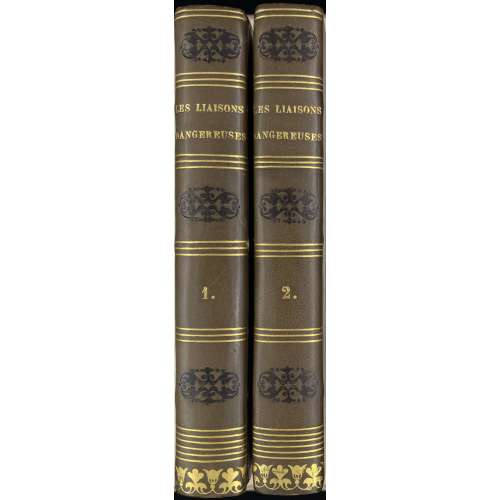 [Choderlos de Laclos.] Les Liaisons dangereuses, lettres recueillies dans une société, et publiées pour l’instruction de quelques autres; par M. C*** de L*** / Ornées de 6 gravures d'après Devéria. — Londres: s.n., 1820. Description: two volumes, collated 12mo, 17.1 x 10.6 cm each, modern binding – recently bound in quarter brown calf with gilt lettering, fillets and black fleurons to spine over green marbled boards; bookplate to front pastedown in each volume: “Ex-Libris | F.-M. Caye”. Printed on laid paper, each volume is illustrated with a frontispiece and two plates engraved by various engravers after Achille Devéria under the direction of Ambroise Tardieu. Title-page: LES LIAISONS | DANGEREUSES, | LETTRES RECUEILLIES | DANS UNE SOCIÉTÉ, | ET PUBLIÉES POUR L’INSTRUCTION DE QUELQUES AUTRES. | PAR M. C*** DE L***. | {3 lines of citation from J.-J. Rousseau} | TOME PREMIER (TOME SECOND) | — | A LONDRES. | ~ | M.D.CCC.XX. || Collation: Vol. 1: π8 1-1412 156, total 182 leaves plus 3 engraved plates: frontispiece and opposite to pp. 37 and 338. Pagination: [1-5] 6-16, [1] 2-348, total 364 pages. Vol. 2: π2 16 2-1512 162, total 178 leaves plus 3 engraved plates: frontispiece and opposite to pp. 25 and 316. Pagination: [4] [1] 2-352, total 356 pages. Provenance: Caye, F.-M. Pierre Ambroise François Choderlos de Laclos (French, 1741 – 1803) – author. Achille Jacques-Jean-Marie Devéria (French, 1800 – 1857) – artist. Engravers: Ambroise Tardieu (French, 1788 – 1841) Jean Baptiste Touzé (French, fl. 1810 – 1830) Jean Jacques Frilley (French, 1797 – after 1850) Achille Lefèvre (French, 1798 – 1864) Jean Louis Toussaint Caron (French, 1790 – 1832)
[Choderlos de Laclos.] Les Liaisons dangereuses, lettres recueillies dans une société, et publiées pour l’instruction de quelques autres; par M. C*** de L*** / Ornées de 6 gravures d'après Devéria. — Londres: s.n., 1820. Description: two volumes, collated 12mo, 17.1 x 10.6 cm each, modern binding – recently bound in quarter brown calf with gilt lettering, fillets and black fleurons to spine over green marbled boards; bookplate to front pastedown in each volume: “Ex-Libris | F.-M. Caye”. Printed on laid paper, each volume is illustrated with a frontispiece and two plates engraved by various engravers after Achille Devéria under the direction of Ambroise Tardieu. Title-page: LES LIAISONS | DANGEREUSES, | LETTRES RECUEILLIES | DANS UNE SOCIÉTÉ, | ET PUBLIÉES POUR L’INSTRUCTION DE QUELQUES AUTRES. | PAR M. C*** DE L***. | {3 lines of citation from J.-J. Rousseau} | TOME PREMIER (TOME SECOND) | — | A LONDRES. | ~ | M.D.CCC.XX. || Collation: Vol. 1: π8 1-1412 156, total 182 leaves plus 3 engraved plates: frontispiece and opposite to pp. 37 and 338. Pagination: [1-5] 6-16, [1] 2-348, total 364 pages. Vol. 2: π2 16 2-1512 162, total 178 leaves plus 3 engraved plates: frontispiece and opposite to pp. 25 and 316. Pagination: [4] [1] 2-352, total 356 pages. Provenance: Caye, F.-M. Pierre Ambroise François Choderlos de Laclos (French, 1741 – 1803) – author. Achille Jacques-Jean-Marie Devéria (French, 1800 – 1857) – artist. Engravers: Ambroise Tardieu (French, 1788 – 1841) Jean Baptiste Touzé (French, fl. 1810 – 1830) Jean Jacques Frilley (French, 1797 – after 1850) Achille Lefèvre (French, 1798 – 1864) Jean Louis Toussaint Caron (French, 1790 – 1832) -
 Artist: Utagawa Kunisada [歌川 国貞] a.k.a. Utagawa Toyokuni III [三代歌川豊国] (Japanese, 1786 – 1865). Signed: Kōchō(rō) Kunisada ga (香蝶国貞画) in a red double-gourd cartouche. Publisher: Surugaya Sakujirō [駿河屋作次郎] (Japanese, fl. c. 1844 – 1865); Marks 06-005 | 501a. Single nanushi censor seal: Muramatsu (1843-6). The date is attributed to c. 1844. Title: Narihira [なり平]. Ariwara no Narihira [在原 業平] (Japanese, 825 – 880) – one of the Six Immortal Poets – The Rokkasen [六歌仙]. Series: A parody of six immortal poets [見立六花撰] (Mitate Rokkasen). Media: Untrimmed fan print (uchiwa-e), 227 x 293 mm, depicting a beautiful woman with a bow and arrows in her left hand. Series: Mitate Rokkasen [見立六花撰] – is sometimes interpreted as "A parody of six immortal poets" or "A comparison of six select flowers". [LIB-1212.2017] Robert Schaap. Kunisada: Imaging, drama and beauty. — Leiden: Hotei Publishing, 2016; pl. 28, p. 58. This is another fan print with another immortal poet, Bun'ya no Yasuhide [文屋 康秀] (Japanese, -d. 885?), from the same series, provided in the book:With special thanks to Horst Graebner for help with the description and date attribution: "The print can be dated to 1844: censor seal is Muramatsu (Muramatsu Genroku); he acted in 7/1844 and 4/1845 (and also later) as censor but Kunisada changed his name to Kunisada early in 1844."
Artist: Utagawa Kunisada [歌川 国貞] a.k.a. Utagawa Toyokuni III [三代歌川豊国] (Japanese, 1786 – 1865). Signed: Kōchō(rō) Kunisada ga (香蝶国貞画) in a red double-gourd cartouche. Publisher: Surugaya Sakujirō [駿河屋作次郎] (Japanese, fl. c. 1844 – 1865); Marks 06-005 | 501a. Single nanushi censor seal: Muramatsu (1843-6). The date is attributed to c. 1844. Title: Narihira [なり平]. Ariwara no Narihira [在原 業平] (Japanese, 825 – 880) – one of the Six Immortal Poets – The Rokkasen [六歌仙]. Series: A parody of six immortal poets [見立六花撰] (Mitate Rokkasen). Media: Untrimmed fan print (uchiwa-e), 227 x 293 mm, depicting a beautiful woman with a bow and arrows in her left hand. Series: Mitate Rokkasen [見立六花撰] – is sometimes interpreted as "A parody of six immortal poets" or "A comparison of six select flowers". [LIB-1212.2017] Robert Schaap. Kunisada: Imaging, drama and beauty. — Leiden: Hotei Publishing, 2016; pl. 28, p. 58. This is another fan print with another immortal poet, Bun'ya no Yasuhide [文屋 康秀] (Japanese, -d. 885?), from the same series, provided in the book:With special thanks to Horst Graebner for help with the description and date attribution: "The print can be dated to 1844: censor seal is Muramatsu (Muramatsu Genroku); he acted in 7/1844 and 4/1845 (and also later) as censor but Kunisada changed his name to Kunisada early in 1844."
Robert Schaap, 2016.
-
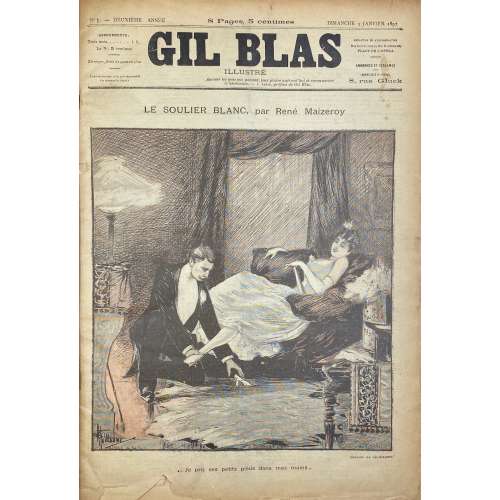 52 issues of French weekly Gil Blas illustré, 1892: №№ 1-52; published in Paris, 39 x 29 cm, bound in red half cloth over marbled boards, with gilt fillets and lettering to spine, marbled endpapers, profusely illustrated by Théophile Steinlen (Swiss-French, 1859 – 1923) and Albert Guillaume (French, 1873 – 1942).
52 issues of French weekly Gil Blas illustré, 1892: №№ 1-52; published in Paris, 39 x 29 cm, bound in red half cloth over marbled boards, with gilt fillets and lettering to spine, marbled endpapers, profusely illustrated by Théophile Steinlen (Swiss-French, 1859 – 1923) and Albert Guillaume (French, 1873 – 1942). -
 Artist: Utagawa Kuniyoshi [歌川 國芳] (1798 – 1861). Kabuki actors Ichikawa Danjūrō VIII and Arashi Rikan III as sumo wrestlers Nuregami Chōgorō (L) and Hanaregoma Chōkichi (R), respectively. Signed: Ichiyûsai Kuniyoshi ga (一勇斎 國芳 画) in a double gourd-shaped cartouche with Yoshi Kiri seal. Publisher: No seal. Date seal and double nanushi censor seal: Mera & Watanabe, 1852. Media: Fan print (uchiwa-e, 団扇絵), 231 x 295 mm. Theme: Nine-act drama (11 scenes) Futatsu Chōchō Kuruwa Nikki [双蝶々曲輪日記] (A Diary of Two Butterflies in the Pleasure Quarters) written by Takeda Izumo II, Namiki Senryū I, Miyoshi Shōraku (7/1749) as puppet play Bunraku [文楽], adopted for Kabuki theatre by Arashi San'emon IV. “The sumo wrestler Nuregami Chōgorō is trying to ransom the courtesan Azuma for Yogoro, in whose debt he stands. Hiraoka Goemon, who is at odds with Yogorō and Azuma, is the patron of the amateur wrestler Hanaregoma Chōkichi. Chōgorō purposely loses to Chōkichi and then asks the latter to stop Goemon's ransoming of Azuma; Chōkichi refuses, however, and they quarrel. Admonished for his dissipation by his sister Oseki, Chōkichi is going to commit ritual suicide (seppuku) as an apology for his behavior, but Chōgorō, who happens along just then, prevents him. The two men swear blood brotherhood. […] The confrontation between Chōgorō and Chōkichi in the Sumōba scene, acted in the exaggerated style called aragoto, is a major highlight of the work. The scene in Yohei's home, known as Hikimado, presents the unfolding of Kabuki's eternal conflict between duty and feelings, here represented by the act of opening the skylight (hikimado) to which Chōgorō is tied”. [Samuel L. Leiter. Kabuki Encyclopedia: an English-language adaptation of Kabuki Jiten. — Westport, CT; London: Greenwood Press, 1979, pp. 70-71]. See also James R. Brandon and Samuel L. Leiter. Kabuki plays on stage, vol. 1, pp. 234-258. — Honolulu: University of Hawai'i Press, 2002. Actors: Ichikawa Danjūrō VIII [市川団十郎] (Japanese, 1823 – 1854); other names: Ichikawa Ebizō VI, Ichikawa Shinnosuke II. Arashi Rikan III [嵐璃寛] (Japanese, 1812 – 1863); other names Arashi Tokusaburō III, Arashi Kicchō I, Onoe Wasaburō I. Another print in this collection with the same theme: SVJP-0331.2020.
Artist: Utagawa Kuniyoshi [歌川 國芳] (1798 – 1861). Kabuki actors Ichikawa Danjūrō VIII and Arashi Rikan III as sumo wrestlers Nuregami Chōgorō (L) and Hanaregoma Chōkichi (R), respectively. Signed: Ichiyûsai Kuniyoshi ga (一勇斎 國芳 画) in a double gourd-shaped cartouche with Yoshi Kiri seal. Publisher: No seal. Date seal and double nanushi censor seal: Mera & Watanabe, 1852. Media: Fan print (uchiwa-e, 団扇絵), 231 x 295 mm. Theme: Nine-act drama (11 scenes) Futatsu Chōchō Kuruwa Nikki [双蝶々曲輪日記] (A Diary of Two Butterflies in the Pleasure Quarters) written by Takeda Izumo II, Namiki Senryū I, Miyoshi Shōraku (7/1749) as puppet play Bunraku [文楽], adopted for Kabuki theatre by Arashi San'emon IV. “The sumo wrestler Nuregami Chōgorō is trying to ransom the courtesan Azuma for Yogoro, in whose debt he stands. Hiraoka Goemon, who is at odds with Yogorō and Azuma, is the patron of the amateur wrestler Hanaregoma Chōkichi. Chōgorō purposely loses to Chōkichi and then asks the latter to stop Goemon's ransoming of Azuma; Chōkichi refuses, however, and they quarrel. Admonished for his dissipation by his sister Oseki, Chōkichi is going to commit ritual suicide (seppuku) as an apology for his behavior, but Chōgorō, who happens along just then, prevents him. The two men swear blood brotherhood. […] The confrontation between Chōgorō and Chōkichi in the Sumōba scene, acted in the exaggerated style called aragoto, is a major highlight of the work. The scene in Yohei's home, known as Hikimado, presents the unfolding of Kabuki's eternal conflict between duty and feelings, here represented by the act of opening the skylight (hikimado) to which Chōgorō is tied”. [Samuel L. Leiter. Kabuki Encyclopedia: an English-language adaptation of Kabuki Jiten. — Westport, CT; London: Greenwood Press, 1979, pp. 70-71]. See also James R. Brandon and Samuel L. Leiter. Kabuki plays on stage, vol. 1, pp. 234-258. — Honolulu: University of Hawai'i Press, 2002. Actors: Ichikawa Danjūrō VIII [市川団十郎] (Japanese, 1823 – 1854); other names: Ichikawa Ebizō VI, Ichikawa Shinnosuke II. Arashi Rikan III [嵐璃寛] (Japanese, 1812 – 1863); other names Arashi Tokusaburō III, Arashi Kicchō I, Onoe Wasaburō I. Another print in this collection with the same theme: SVJP-0331.2020. Reference images:
Reference images:
-
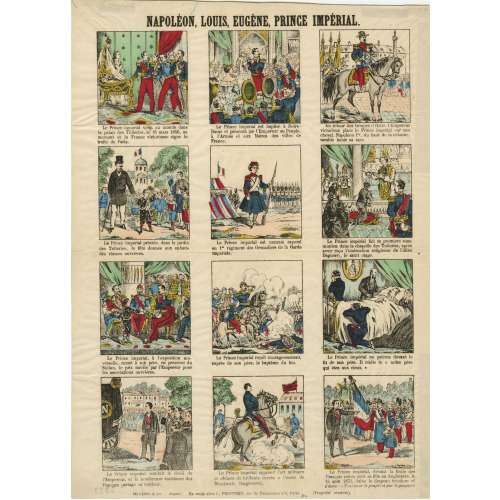 Another copy of SVFC-0745-3.2023, 395 x 290 mm; black ink stamp “5322” to reverse. Jean Charles Pellerin (French, 1756 – 1836)
Another copy of SVFC-0745-3.2023, 395 x 290 mm; black ink stamp “5322” to reverse. Jean Charles Pellerin (French, 1756 – 1836) -
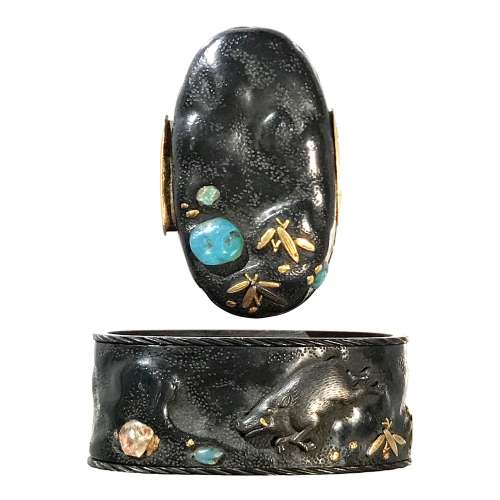 Signature: Unsigned
Signature: UnsignedFuchi-kashira with rock and boar (iwa ni inoshishi zu) motif. Inlay of precious stones or colour glass. Shakudō, gold, gemstones. Technique: Sukibori zogan kiniroe.
Fuchi: 36 x 21 x 14 mm; Weight: 22 g; Kashira: 32 x 17 x 5 mm; Weight: 8 g; Material : Shakudō; Gold; Gemstones (Chalcedony and Rose Quartz). Possibly, Owari school. -
 Artist: Utagawa Toyokuni I (1769–1825) Title: Actors Bando Mitsugorō, Ichikawa Danjūrō, Onoe Kikugorō in play The Maiden at Dōjō Temple. Presumably Bunka 13 (1816) at Nakamura Theater in Edo. Publisher: Mikawaya Seiemon (c. 1805-1829); Marks' "Publishers" № 328, p. 235. Size: Vertical ôban MEDIUM OR TECHNIQUE: Woodblock print (nishiki-e); ink and color on paper. Signed: Toyokuni ga Censor's seal: kiwame Detailed discussion on the topic can be seen at: The Maiden at Dōjō Temple
Artist: Utagawa Toyokuni I (1769–1825) Title: Actors Bando Mitsugorō, Ichikawa Danjūrō, Onoe Kikugorō in play The Maiden at Dōjō Temple. Presumably Bunka 13 (1816) at Nakamura Theater in Edo. Publisher: Mikawaya Seiemon (c. 1805-1829); Marks' "Publishers" № 328, p. 235. Size: Vertical ôban MEDIUM OR TECHNIQUE: Woodblock print (nishiki-e); ink and color on paper. Signed: Toyokuni ga Censor's seal: kiwame Detailed discussion on the topic can be seen at: The Maiden at Dōjō Temple -
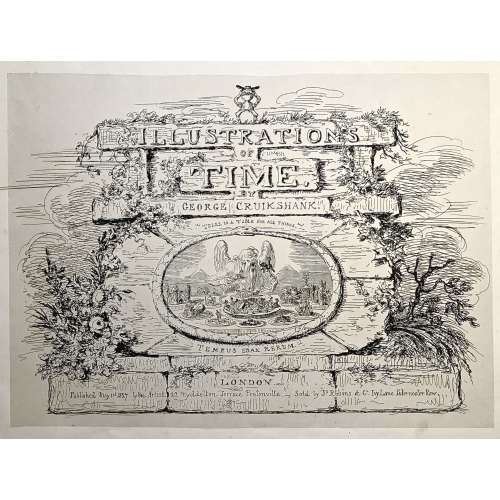
Engraved title page: ILLUSTRATION | OF | TIME. | GEORGE CRUIKSHANK. | "THERE IS A TIME FOR ALL THINGS". | TEMPUS EDAX RERUM. | LONDON | Published May 1st 1827 by the Artist - 22 Myddelton Terrace Pentonville. - Sold by Js. Robins & Co. Ivy Lane Paternoster Row.
Oblong folio, 33.5 x 44 cm. Engraved vignette title page and six not-coloured engraved plates with multiple images showing thirty-five humorous scenes.
First edition, first issue. Uncoloured. Pristine condition.
Half-leather bound in marbled cardboard and red morocco and gild lettering and arabesque. Frontispiece and 6 plates with protective tissues.
Content:1. Time-Called & Time-Come (five sketches)
2. Behind Time (seven sketches)
3. Time Thrown Away (six sketches)
4. Hard Times [&] Term Time (five sketches)
5. Time Badly Employed (five sketches)
6. Christmas Time (seven sketches)
British Museum № 1978,U.3026.1. BM description: "Frontispiece, the title on a background of symmetrical but dilapidated and grass-grown masonry. On the summit stands a little laughing gnome, with a wide hat and a body formed of an hour-glass; Inset is an oval bordered by a serpent with its tail in its mouth (emblem of eternity), in which is an aged and all-devouring Time (bald except for a forelock), seated behind a table whose surface is the base of the design. He puts to his mouth a fork on which is speared an elephant with a castle on its back containing tiny figures with spears. In his r. hand is a spoon containing a country church. His table is covered with dishes, and at his r. hand is a sickle. The central and biggest dish is heaped with a jumble of tiny objects: crown, table, chair, wheelbarrow, picture; round the room sit little figures: a soldier, parson, lady and child, &c. The ten other dishes contain: an antique glass coach with horses and footmen; an overladen camel beside a palm-tree; ruins of a castle; a farmhouse; a shepherd and sheep; a dismantled cannon and balls, cattle, a man-of-war in full sail; a ruinous Gothic cathedral; a clump of trees (the last two are dominated by a large decanter). Below Time are two (Egyptian) pyramids. Above: 'There Is A Time For All Things'; below: 'Tempus Edax Rerum'. 1 May 1827. Etching."Bibliography:- Reid, G W, A descriptive catalogue of the works of George Cruikshank, London, 1871.
- Stephens, Frederic George; George, Mary Dorothy, Catalogue of Political and Personal Satires in the Department of Prints and Drawings in the British Museum, 11 vols, London, BMP, 1870.
- Cohn, A M, George Cruikshank, catalogue raisonné, London, 1924.
-
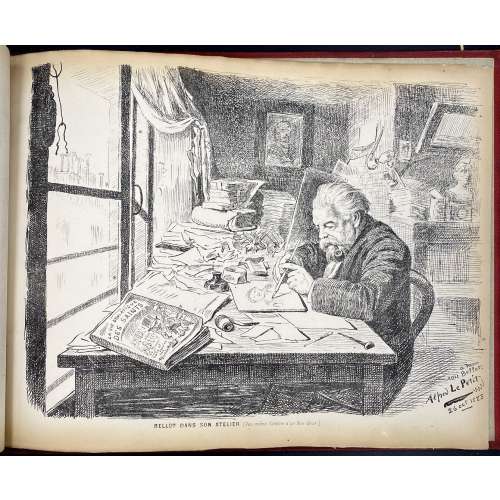 An album of the "Le Bon-Bock" dinners for the year 1884. Author, designer and publisher – Emile Bellot (French, 1831 – 1886), a Parisian artist and engraver. "Le Bon-Bock" was a monthly dinner of artists and men of letters, who gathered in Paris for good food, good company, and artistic performances, from 1875 to at least 1925. The story behind these gatherings as told by Emile Bellot, the founder, is this:
An album of the "Le Bon-Bock" dinners for the year 1884. Author, designer and publisher – Emile Bellot (French, 1831 – 1886), a Parisian artist and engraver. "Le Bon-Bock" was a monthly dinner of artists and men of letters, who gathered in Paris for good food, good company, and artistic performances, from 1875 to at least 1925. The story behind these gatherings as told by Emile Bellot, the founder, is this:In February 1875, Pierre Cottin1 came to me and said: 'I discovered a poet and tragedian of immense talent and who interprets the poems of the Great Victor Hugo in an astonishing way. Monsieur Gambini. I promised him that I would make it heard by an audience of artists and men of letters. I am counting on you who have many connections to keep my promise to him'. I gathered about 25 of my friends and acquaintances in a picnic dinner which took place at a restaurant 'Krauteimer' on the rue Rochechouart in Montmartre. They heard from Mr Gambini first, then my friends Étienne Carjat2, J. Gros3, Adrien Dézamy4, etc. performed. These gentlemen completed the evening so brilliantly that it was unanimously decided that we would start a similar dinner every month. Poets, musicians, men of letters, singers would be invited to this dinner. I was in charge of the organization of this little party and as it was the dream of my life to bring together old comrades, I was careful not to refuse and I pursued this good idea. Cottin and René Tener5 were kind enough to help me in this joyous task and especially my old friend Carjat. The following March began our 1st monthly dinner.
The name "Le Bon-Bock" means "The Good Bock", whilst Bock is a kind of beer, a dark, malty, lightly hopped ale. The dinner was named "Le Bon-Bock" in honour of the Éduard Manet painting (1873), a famous portrait of Emile Bellot, called "Le Bon-Bock".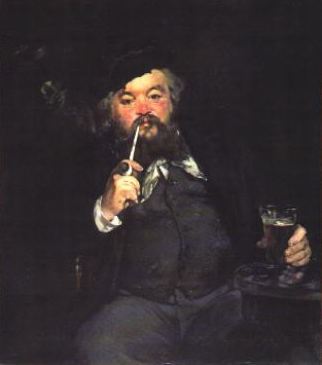 The invitations to the dinner were also produced by the artists and looked like this one by Alexandre Ferdinandus (October 3, 1883).
The invitations to the dinner were also produced by the artists and looked like this one by Alexandre Ferdinandus (October 3, 1883).
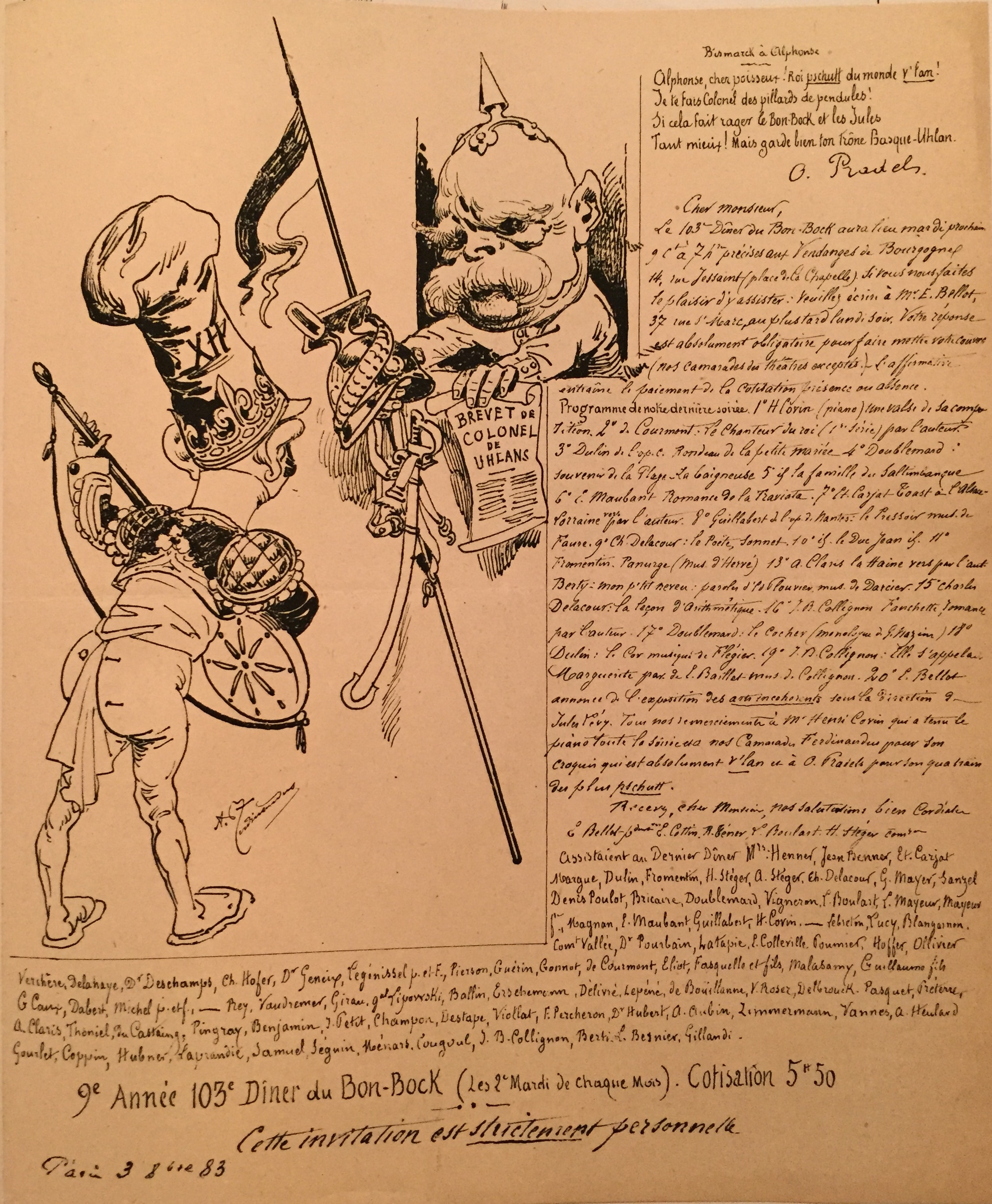 Besides this sketch of the Parisian social and artistic life at the end of the 19th century, the provenance of the album in our collection generates additional interest. The ink stamp to the front flyleaf reads: "Docteur Henry Uzan, 29 Avenue Perrichont, Paris XVI".
Doctor Henry Uzan was Jewish. He was arrested by the Pétain police on October 1, 1941, and interned in Drancy. With the few means at his disposal, he undertook to treat the sick whom he then saw leaving, week after week, towards their terrible destiny in the extermination camps. In October 1943 doctor Uzan was deported to the island of Alderney. After the Normandy Landing of June 6, 1944, Nazis evacuated the island detainees and transfer them to the Neuengamme camp, via northern France and Belgium. During the transfer, doctor Uzan managed to escape from the train on the night of September 3 to 4 around Dixmude in Flanders. He was taken in by the Belgian Resistance, which he joined before being repatriated to France.
In France, he continued working as a physician and was one of the founders of Association des internés et déportés politiques (AIDP). In 1945, together with his friends, the doctor designed the symbol for the Fédération nationale des déportés et internés résistants et patriotes:
Besides this sketch of the Parisian social and artistic life at the end of the 19th century, the provenance of the album in our collection generates additional interest. The ink stamp to the front flyleaf reads: "Docteur Henry Uzan, 29 Avenue Perrichont, Paris XVI".
Doctor Henry Uzan was Jewish. He was arrested by the Pétain police on October 1, 1941, and interned in Drancy. With the few means at his disposal, he undertook to treat the sick whom he then saw leaving, week after week, towards their terrible destiny in the extermination camps. In October 1943 doctor Uzan was deported to the island of Alderney. After the Normandy Landing of June 6, 1944, Nazis evacuated the island detainees and transfer them to the Neuengamme camp, via northern France and Belgium. During the transfer, doctor Uzan managed to escape from the train on the night of September 3 to 4 around Dixmude in Flanders. He was taken in by the Belgian Resistance, which he joined before being repatriated to France.
In France, he continued working as a physician and was one of the founders of Association des internés et déportés politiques (AIDP). In 1945, together with his friends, the doctor designed the symbol for the Fédération nationale des déportés et internés résistants et patriotes:
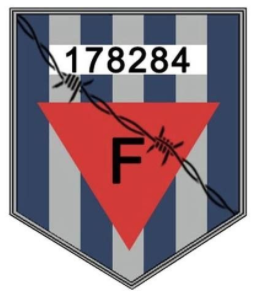 The story behind the number on the emblem (178284) is fascinating but it is out of the scope of this material.
The story behind the number on the emblem (178284) is fascinating but it is out of the scope of this material.
1. Pierre Cottin (French, 1823 – c. 1887) – Engraver, mezzotinter, genre and landscape painter; born in Chappelle-Saint-Denis (near Paris), a pupil of Jazet. Exhibited at the Salon from 1845, also in London from 1876 to 1879.↩ 2. Étienne Carjat (French, 1828 – 1906) – Journalist, caricaturist and photographer. ↩ 3. Jean Baptiste Louis Gros (French, 1793 – 1870) – Painter. ↩ 4. Adrien Dézamy (French, 1844 – 1891) – Writer, poet, general secretary of the Théâtre des Bouffes in Paris. ↩ 5. Rene Tener (French, 1846 – 1925) – Painter. ↩ Sources:Auguste Lepage. Les dîners artistiques et littéraires de Paris / Bibliothèque des Deux mondes (2e éd.) – Paris: Frinzine, Klein et Cie., 1884. [Accession № LIB-2606.2021 in this collection]
-
![Adelbert von Chamisso. Peter Schlemihl's wundersame Geschichte. Nach des Dichters Tode neu herausgegeben von Julius Eduard Hitzig. Stereotypausgabe mit Holzschnitten. — Nürnberg: Johann Leonhard Schrag, [o.J.], [1839]. — XVI + 83 S.](https://varshavskycollection.com/wp-content/uploads/2021/02/LIB-1100.2016-b-scaled-500x500.jpeg) Title page (in Gothic script): Peter Schlemihl's | wundersame Geschichte | mitgetheilt | von | Adelbert von Chamisso. | {vignette} | Nach des Dichters Tode neu herausgegeben | von Julius Eduard Hitzig. | Stereotypausgabe mit Holzschnitten. | Nürnberg, | Johann Leonhard Schrag. || Pagination: [i-iii] iv-xvi, [1] 2-82 [2], 15 woodcut vignettes by Unzelmann after Menzel. Collation: 8vo; π8 1-58 62. Binding: 21.5 x 13.5 cm, blind olive wrappers. Year of publication inferred from the foreword. This is the first posthumous edition of Chamisso's novel. Personae: Chamisso, Adelbert von (German, 1781 – 1838). — Author of the text. Hitzig, Julius Eduard [Itzig, Isaac Elias] (German-Jewish, 1780 – 1849). — Author of the foreword. Menzel, Adolph Friedrich Erdmann von (German, 1815 – 1905). — Artist of the vignettes. Unzelmann, Friedrich Ludwig (German, 1797 – 1854). — Engraver of the woodcuts. Schrag, Johann Leonhard (Germany, 1783 – 1858). — Publisher.
Title page (in Gothic script): Peter Schlemihl's | wundersame Geschichte | mitgetheilt | von | Adelbert von Chamisso. | {vignette} | Nach des Dichters Tode neu herausgegeben | von Julius Eduard Hitzig. | Stereotypausgabe mit Holzschnitten. | Nürnberg, | Johann Leonhard Schrag. || Pagination: [i-iii] iv-xvi, [1] 2-82 [2], 15 woodcut vignettes by Unzelmann after Menzel. Collation: 8vo; π8 1-58 62. Binding: 21.5 x 13.5 cm, blind olive wrappers. Year of publication inferred from the foreword. This is the first posthumous edition of Chamisso's novel. Personae: Chamisso, Adelbert von (German, 1781 – 1838). — Author of the text. Hitzig, Julius Eduard [Itzig, Isaac Elias] (German-Jewish, 1780 – 1849). — Author of the foreword. Menzel, Adolph Friedrich Erdmann von (German, 1815 – 1905). — Artist of the vignettes. Unzelmann, Friedrich Ludwig (German, 1797 – 1854). — Engraver of the woodcuts. Schrag, Johann Leonhard (Germany, 1783 – 1858). — Publisher. -
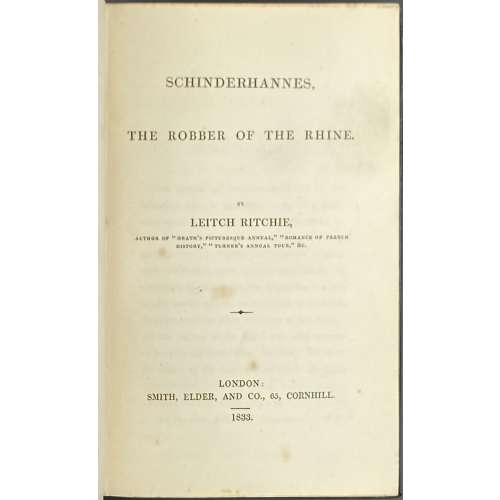 Serial title: THE | LIBRARY OF ROMANCE. | EDITED | BY LEITCH RITCHIE. | VOL. II. | — | SCHINDERHANNES, | THE ROBBER OF THE RHINE. | BY THE EDITOR. | — | LONDON: | SMITH, ELDER, AND CO., 65, CORNHILL. | — | 1833. || Title page: SCHINDERHANNES, | THE ROBBER OF THE RHINE. | BY | LEITCH RITCHIE, | AUTHOR OF “HEATH’S PICTURESQUE ANNUAL,” “ROMANCE OF FRENCH | HISTORY,” “TURNER’S ANNUAL TOUR,” &c. | — | LONDON: | SMITH, ELDER, AND CO., 65, CORNHILL. | — | 1833. || Pagination: [1] 2 – prospectus, [i, ii] – serial title / imprint, [iii-iv] – t.p. / blank, [v] vi (mispaged iv) – advert. [vii] viii – contents, [2] f.t. / blank; [1] 2-314 – text, [2] – advert. vol. I and III; total number of pages 12+314+2=328 Collation: 8vo; π6 B-U8 X4 Y2, total number of leaves 164. Binding: 18 x 11.5 cm, dark green buckram (faux morocco), gilt lettering and design elements to spine, printer’s imprint to π4: Bradbury and Evans, moiré endpapers. Cat. raisonné: Sadleir (v.2) 3760a, p. 171. Contributors: Leitch Ritchie (British-Scottish, 1800 – 1865) – author. Schinderhannes [Johannes Bückler] (German, c.1778 – 1803) – character. Bradbury & Evans (est.1830) – printer. Smith, Elder, and Company (1816 - 1917) – publisher. George Smith (British-Scottish, 1789 – 1846) – publisher. George Murray Smith (British, 1824 – 1901) – publisher. Alexander Elder (British, 1790 – 1876) – publisher.
Serial title: THE | LIBRARY OF ROMANCE. | EDITED | BY LEITCH RITCHIE. | VOL. II. | — | SCHINDERHANNES, | THE ROBBER OF THE RHINE. | BY THE EDITOR. | — | LONDON: | SMITH, ELDER, AND CO., 65, CORNHILL. | — | 1833. || Title page: SCHINDERHANNES, | THE ROBBER OF THE RHINE. | BY | LEITCH RITCHIE, | AUTHOR OF “HEATH’S PICTURESQUE ANNUAL,” “ROMANCE OF FRENCH | HISTORY,” “TURNER’S ANNUAL TOUR,” &c. | — | LONDON: | SMITH, ELDER, AND CO., 65, CORNHILL. | — | 1833. || Pagination: [1] 2 – prospectus, [i, ii] – serial title / imprint, [iii-iv] – t.p. / blank, [v] vi (mispaged iv) – advert. [vii] viii – contents, [2] f.t. / blank; [1] 2-314 – text, [2] – advert. vol. I and III; total number of pages 12+314+2=328 Collation: 8vo; π6 B-U8 X4 Y2, total number of leaves 164. Binding: 18 x 11.5 cm, dark green buckram (faux morocco), gilt lettering and design elements to spine, printer’s imprint to π4: Bradbury and Evans, moiré endpapers. Cat. raisonné: Sadleir (v.2) 3760a, p. 171. Contributors: Leitch Ritchie (British-Scottish, 1800 – 1865) – author. Schinderhannes [Johannes Bückler] (German, c.1778 – 1803) – character. Bradbury & Evans (est.1830) – printer. Smith, Elder, and Company (1816 - 1917) – publisher. George Smith (British-Scottish, 1789 – 1846) – publisher. George Murray Smith (British, 1824 – 1901) – publisher. Alexander Elder (British, 1790 – 1876) – publisher. -
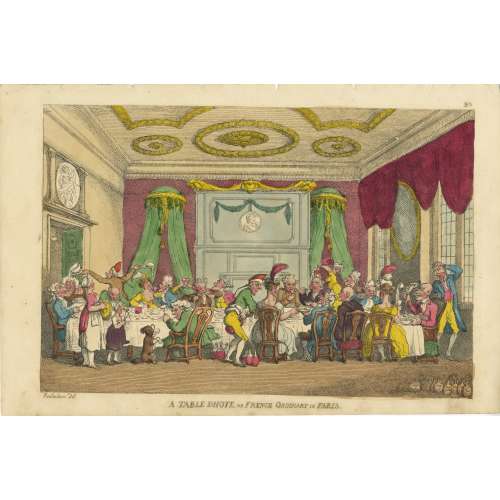 Hand-coloured etching by Thomas Rowlandson, printed on May 30, 1810, in London; № 20 from the series The Caricature Magazine or Hudibrastic Mirror Vol. 2. Description by Metropolitan Museum (59.533.978): "Guests of a dinner sit at a long narrow table in a magnificent room with an ornate ceiling. Two men and a young woman serve wine, one drawing a cork, the others spilling wine over the guests. Another waiter spills soup in an elderly guest's face. A woman and a little girl with a begging dog play tambourine and triangle at left." Inscribed in plate lower left: "Rowlandson Del."; bottom centre: "A TABLE DHOTE, OR FRENCH ORDINARY IN PARIS." Our copy is lacking the publication details: "Pub.d May 30. 1810 by Tho.s Tegg 111 Cheapside, London." and similar to the copy in Boston Public Library (18_03_000394). Dimensions: Sheet 27 x 40.5 cm; Image: 23.5 x 35 cm. Contributors: Thomas Rowlandson (British, 1756 – 1827) – artist. Thomas Tegg (British, 1776 – 1846) – publisher.
Hand-coloured etching by Thomas Rowlandson, printed on May 30, 1810, in London; № 20 from the series The Caricature Magazine or Hudibrastic Mirror Vol. 2. Description by Metropolitan Museum (59.533.978): "Guests of a dinner sit at a long narrow table in a magnificent room with an ornate ceiling. Two men and a young woman serve wine, one drawing a cork, the others spilling wine over the guests. Another waiter spills soup in an elderly guest's face. A woman and a little girl with a begging dog play tambourine and triangle at left." Inscribed in plate lower left: "Rowlandson Del."; bottom centre: "A TABLE DHOTE, OR FRENCH ORDINARY IN PARIS." Our copy is lacking the publication details: "Pub.d May 30. 1810 by Tho.s Tegg 111 Cheapside, London." and similar to the copy in Boston Public Library (18_03_000394). Dimensions: Sheet 27 x 40.5 cm; Image: 23.5 x 35 cm. Contributors: Thomas Rowlandson (British, 1756 – 1827) – artist. Thomas Tegg (British, 1776 – 1846) – publisher. -
 Title: Fourth lunar month [卯月] (Uzuki no zu); Series: Fashionable Twelve Months (Imayo juni-kagetsu). Another version of translation: Modern Beauties of Twelve Months. Artist: Utagawa Toyokuni I [歌川豊国] (1769–1825). Pubisher: Ibaya Senzaburō [伊場屋仙三郎] (Japanese, 1815 – 1869), seal: Dansendō [伊場仙]. Signed: Toyokuni ga and sealed with toshidama. Date-kiwame seal: Ushi (ox), Bunsei 5 (1822). Size: double-sheet uncut fan print ( aiban uchiwa-e), 219 x 295 mm.
Title: Fourth lunar month [卯月] (Uzuki no zu); Series: Fashionable Twelve Months (Imayo juni-kagetsu). Another version of translation: Modern Beauties of Twelve Months. Artist: Utagawa Toyokuni I [歌川豊国] (1769–1825). Pubisher: Ibaya Senzaburō [伊場屋仙三郎] (Japanese, 1815 – 1869), seal: Dansendō [伊場仙]. Signed: Toyokuni ga and sealed with toshidama. Date-kiwame seal: Ushi (ox), Bunsei 5 (1822). Size: double-sheet uncut fan print ( aiban uchiwa-e), 219 x 295 mm.

-
 Artist: Utagawa Kunisada [歌川 国貞] a.k.a. Utagawa Toyokuni III [三代歌川豊国] (Japanese, 1786 – 1865). Signed: Ichiyōsai Toyokuni hitsu [一陽斎豊国筆]. Inscriptions: [松竹梅] Shochikubai = pine (matsu, 松), bamboo (take, 竹), and plum (ume, 梅) – an auspicious grouping known as “The Three Friends of Winter“; [三福追] (Sanpuku tsui) – the three delights, or pleasures. Date seal and aratame censor seal: Ansei 2, 1st month (1855). Publisher: Ibaya Senzaburō [伊場屋仙三郎] (Japanese, c. 1815 – 1869). Block carver: Yokokawa Takejirō [横川竹二郎] (Japanese, fl. 1845 – 1863); seal: Hori Take [彫竹]. Kabuki actor Onoe Kikugorō V [五代目尾上菊五郎] (Onoe Baikō V, Ichimura Kakitsu IV, Ichimura Uzaemon XIII, Ichimura Kurōemon, Japanese, 1844 – 1903) giving candies to the memorial portrait of his predecessor, Ichimura Takenojō V [市村竹之丞] (Ichimura Uzaemon XII, Ichimura Kamenosuke, Ichimura Toyomatsu, Japanese, 1812 – 1851); the latter is dressed in a green robe adorned with a crest (mon) of a kōrin-style crane in a tortoiseshell (octagon), the hanging scroll border decorated with bamboo under snow; the collar of Onoe's kimono decorated with plum blossoms, another plum blossom arrangement decorates the screen behind him. Actors identified by Horst Graebner. Two fan prints from this series in Varshavsky Collection:
Artist: Utagawa Kunisada [歌川 国貞] a.k.a. Utagawa Toyokuni III [三代歌川豊国] (Japanese, 1786 – 1865). Signed: Ichiyōsai Toyokuni hitsu [一陽斎豊国筆]. Inscriptions: [松竹梅] Shochikubai = pine (matsu, 松), bamboo (take, 竹), and plum (ume, 梅) – an auspicious grouping known as “The Three Friends of Winter“; [三福追] (Sanpuku tsui) – the three delights, or pleasures. Date seal and aratame censor seal: Ansei 2, 1st month (1855). Publisher: Ibaya Senzaburō [伊場屋仙三郎] (Japanese, c. 1815 – 1869). Block carver: Yokokawa Takejirō [横川竹二郎] (Japanese, fl. 1845 – 1863); seal: Hori Take [彫竹]. Kabuki actor Onoe Kikugorō V [五代目尾上菊五郎] (Onoe Baikō V, Ichimura Kakitsu IV, Ichimura Uzaemon XIII, Ichimura Kurōemon, Japanese, 1844 – 1903) giving candies to the memorial portrait of his predecessor, Ichimura Takenojō V [市村竹之丞] (Ichimura Uzaemon XII, Ichimura Kamenosuke, Ichimura Toyomatsu, Japanese, 1812 – 1851); the latter is dressed in a green robe adorned with a crest (mon) of a kōrin-style crane in a tortoiseshell (octagon), the hanging scroll border decorated with bamboo under snow; the collar of Onoe's kimono decorated with plum blossoms, another plum blossom arrangement decorates the screen behind him. Actors identified by Horst Graebner. Two fan prints from this series in Varshavsky Collection:
SVJP-0335.2021
-
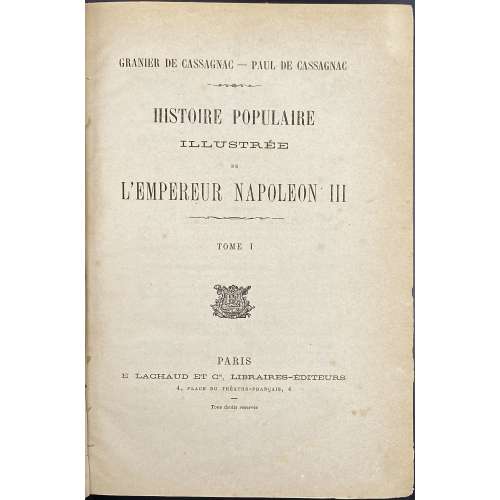 Hardcover, 28 x 20 cm, quarter sheepskin over marbled boards, marbled endpapers, gilt lettering to flat spine with gilt fillet bands, clipping pasted to front fep verso. Title-page: GRANIER DE CASSAGNAC — PAUL DE CASSAGNAC | ~ | HISTOIRE POPULAIRE | ILLUSTRÉE | DE | L'EMPEREUR NAPOLEON III | TOME I (II) | {publisher’s device} | PARIS | E. LACHAUD ET Cie, LIBRAIRES-ÉDITEURS | 4, PLACE DU THÉATRE-FRANÇAIS, 4 | – | Tous droits réservés || Collation: (v.1) π2 [1]-504, (v.2) π2 1-494; total 400 leaves plus albumen photograph pasted to frontispiece and 96 full-page woodcuts within collation. Pagination: [4] [1] 2-398 [2], [4] [1] 2-390 [2], ils.; total 800 pp. Contributors: Bernard Adolphe Granier de Cassagnac (French, 1806 – 1880) – father. Paul Adolphe Marie Prosper Granier de Cassagnac (French, 1843 – 1904) – son.
Hardcover, 28 x 20 cm, quarter sheepskin over marbled boards, marbled endpapers, gilt lettering to flat spine with gilt fillet bands, clipping pasted to front fep verso. Title-page: GRANIER DE CASSAGNAC — PAUL DE CASSAGNAC | ~ | HISTOIRE POPULAIRE | ILLUSTRÉE | DE | L'EMPEREUR NAPOLEON III | TOME I (II) | {publisher’s device} | PARIS | E. LACHAUD ET Cie, LIBRAIRES-ÉDITEURS | 4, PLACE DU THÉATRE-FRANÇAIS, 4 | – | Tous droits réservés || Collation: (v.1) π2 [1]-504, (v.2) π2 1-494; total 400 leaves plus albumen photograph pasted to frontispiece and 96 full-page woodcuts within collation. Pagination: [4] [1] 2-398 [2], [4] [1] 2-390 [2], ils.; total 800 pp. Contributors: Bernard Adolphe Granier de Cassagnac (French, 1806 – 1880) – father. Paul Adolphe Marie Prosper Granier de Cassagnac (French, 1843 – 1904) – son. -
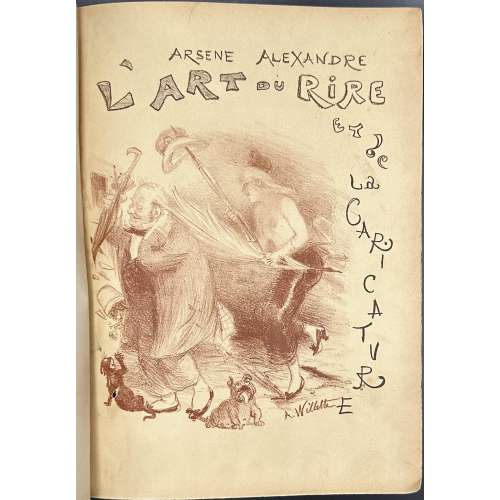 Hardcover volume 28.5 x 20.8 cm, quarter brown morocco over marbled boards, ruled in gilt, spine with raised bands, gilt in compartments, gilt lettering, marbled endpapers, top margin gilt, original lithographic wrappers designed by A. Willette preserved; pp.: [4] h.t., t.p., [1] 2-350 [2], 300 b/w ils in-text and 12 coloured photomechanical reproductions extraneous to collation; collated in-4o: π2 1-444; Title-page: L'ART DU RIRE | ET DE | LA CARICATURE | PAR ARSÈNE ALEXANDRE | 300 FAC-SIMILÉS EN NOIR ET 12 PLANCHES EN COULEURS | D’APRÈS LES ORIGINAUX | {vignette} | PARIS | ANCIENNE MAISON QUANIN | LIBRAIRIES-IMPRIMERIES RÉUNIES | 7, RUE ST-BENOIT | MAY & MOTTEROZ, DIRECTEURS || Contributors : Librairie-Imprimerie réunies (Paris, 1880-1908) – publisher. Arsène Alexandre (French, 1859 – 1937) – author. Adolphe Willette (French, 1857 – 1926) – artist (wrapper)
Hardcover volume 28.5 x 20.8 cm, quarter brown morocco over marbled boards, ruled in gilt, spine with raised bands, gilt in compartments, gilt lettering, marbled endpapers, top margin gilt, original lithographic wrappers designed by A. Willette preserved; pp.: [4] h.t., t.p., [1] 2-350 [2], 300 b/w ils in-text and 12 coloured photomechanical reproductions extraneous to collation; collated in-4o: π2 1-444; Title-page: L'ART DU RIRE | ET DE | LA CARICATURE | PAR ARSÈNE ALEXANDRE | 300 FAC-SIMILÉS EN NOIR ET 12 PLANCHES EN COULEURS | D’APRÈS LES ORIGINAUX | {vignette} | PARIS | ANCIENNE MAISON QUANIN | LIBRAIRIES-IMPRIMERIES RÉUNIES | 7, RUE ST-BENOIT | MAY & MOTTEROZ, DIRECTEURS || Contributors : Librairie-Imprimerie réunies (Paris, 1880-1908) – publisher. Arsène Alexandre (French, 1859 – 1937) – author. Adolphe Willette (French, 1857 – 1926) – artist (wrapper) -
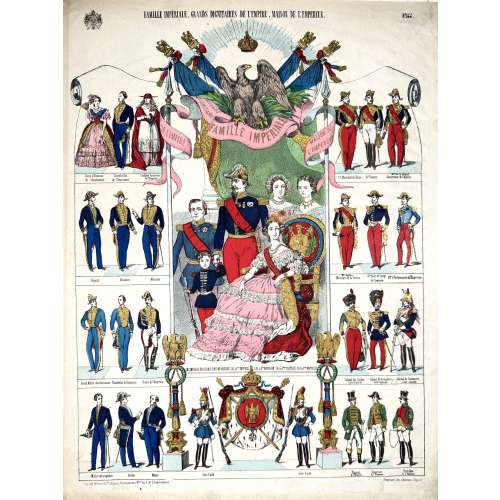 Hand-coloured woodcut on wove paper, 487 x 365 mm; black ink stamp “5056” to reverse. Top left: imperial coat of arms; centre: "FAMILLE IMPERIALE. GRANDS DIGNITAIRES DE L'EMPIRE, MAISON DE L'EMPEREUR."; right: "№144." Image of the imperial family under imperial eagle and standards; besides – four tiers of captioned cartoons. Bottom left: "Imprimerie Lith. de Pellerin, à Épinal"; right: "Propriété de l’Éditeur. — Déposé." Jean Charles Pellerin (French, 1756 – 1836) – printer/publisher.
Hand-coloured woodcut on wove paper, 487 x 365 mm; black ink stamp “5056” to reverse. Top left: imperial coat of arms; centre: "FAMILLE IMPERIALE. GRANDS DIGNITAIRES DE L'EMPIRE, MAISON DE L'EMPEREUR."; right: "№144." Image of the imperial family under imperial eagle and standards; besides – four tiers of captioned cartoons. Bottom left: "Imprimerie Lith. de Pellerin, à Épinal"; right: "Propriété de l’Éditeur. — Déposé." Jean Charles Pellerin (French, 1756 – 1836) – printer/publisher. -
 Utagawa Toyokuni (歌川豐國); 1769 – 24 February 1825. Actor Onoe Matsusuke II as Katsugiino (right), actor Sawamura Tanosuke II as Otsuyu (left) 尾上松助(二代目)in a role かつぎいの; 沢村田之助(二代目) in a role おつゆ. Play: "Yuki to Tsuki Hana no Kuronushi". Theater: Nakamura. Publisher: Mikawaua Seiemon (1805-1829) [Marks: 328]. Circa 1810.
Utagawa Toyokuni (歌川豐國); 1769 – 24 February 1825. Actor Onoe Matsusuke II as Katsugiino (right), actor Sawamura Tanosuke II as Otsuyu (left) 尾上松助(二代目)in a role かつぎいの; 沢村田之助(二代目) in a role おつゆ. Play: "Yuki to Tsuki Hana no Kuronushi". Theater: Nakamura. Publisher: Mikawaua Seiemon (1805-1829) [Marks: 328]. Circa 1810. -
 A two-volume set: (1) Thomas Hugo. The Bewick Collector. A Descriptive Catalogue of the Works of Thomas and John Bewick; Including cuts, in various states, for Books and Pamphlets, Private Gentlemen, Public Companies, Exhibitions, Races, Newspapers, Shop Cards, Invoice Heads, Bar Bills, Coal Certificates, Broadsides, and other miscellaneous purposes, and Wood Blocks. With an Appendix of Portraits, Autographs, Works of Pupils, etc., etc. The whole described from the Originals contained in the largest and most perfect collection ever formed, and illustrated with a hundred and twelve cuts. — London: Lovell Reeve and Co., MDCCCLXVI [1866]. — [Printed by] J. E. Taylor and Co., printers. — pp.: [i-v] vi-xxiii [xxiv], [1] 2-562. (2) Thomas Hugo. The Bewick Collector. A Supplement to a Descriptive Catalogue of the Works of Thomas and John Bewick; Consisting of additions to the various divisions of cuts, wood blocks. etc., enumerated in that work. The whole described from the Originals contained in the largest and most perfect collection ever formed, and illustrated with a hundred and eighty cuts. — London: L. Reeve and Co, MDCCCLXVIII [1868]. — [Printed by] J. E. Taylor and Co., printers. — pp.: [i-vii] viii-xxxii, [1] 2-353. Both volumes in 8vo, 22.5 x 14.5 cm, hardcover. Contemporary dark brown half morocco, gilt-ruled, with 5 raised bands, gilt titles and decoration to spine, and marbled paper over boards. Top edge gilt; marbled endpapers. Binding splitting at pp.80/81 of the 1st volume. Armorial bookplate of Ralph Hart Tweddle to front pastedown. Ralph Hart Tweddle (1843 – 1895) was a British mechanical engineer, known particularly for inventing the portable hydraulic riveter, which greatly facilitated the construction of boilers, bridges and ships.
A two-volume set: (1) Thomas Hugo. The Bewick Collector. A Descriptive Catalogue of the Works of Thomas and John Bewick; Including cuts, in various states, for Books and Pamphlets, Private Gentlemen, Public Companies, Exhibitions, Races, Newspapers, Shop Cards, Invoice Heads, Bar Bills, Coal Certificates, Broadsides, and other miscellaneous purposes, and Wood Blocks. With an Appendix of Portraits, Autographs, Works of Pupils, etc., etc. The whole described from the Originals contained in the largest and most perfect collection ever formed, and illustrated with a hundred and twelve cuts. — London: Lovell Reeve and Co., MDCCCLXVI [1866]. — [Printed by] J. E. Taylor and Co., printers. — pp.: [i-v] vi-xxiii [xxiv], [1] 2-562. (2) Thomas Hugo. The Bewick Collector. A Supplement to a Descriptive Catalogue of the Works of Thomas and John Bewick; Consisting of additions to the various divisions of cuts, wood blocks. etc., enumerated in that work. The whole described from the Originals contained in the largest and most perfect collection ever formed, and illustrated with a hundred and eighty cuts. — London: L. Reeve and Co, MDCCCLXVIII [1868]. — [Printed by] J. E. Taylor and Co., printers. — pp.: [i-vii] viii-xxxii, [1] 2-353. Both volumes in 8vo, 22.5 x 14.5 cm, hardcover. Contemporary dark brown half morocco, gilt-ruled, with 5 raised bands, gilt titles and decoration to spine, and marbled paper over boards. Top edge gilt; marbled endpapers. Binding splitting at pp.80/81 of the 1st volume. Armorial bookplate of Ralph Hart Tweddle to front pastedown. Ralph Hart Tweddle (1843 – 1895) was a British mechanical engineer, known particularly for inventing the portable hydraulic riveter, which greatly facilitated the construction of boilers, bridges and ships. -
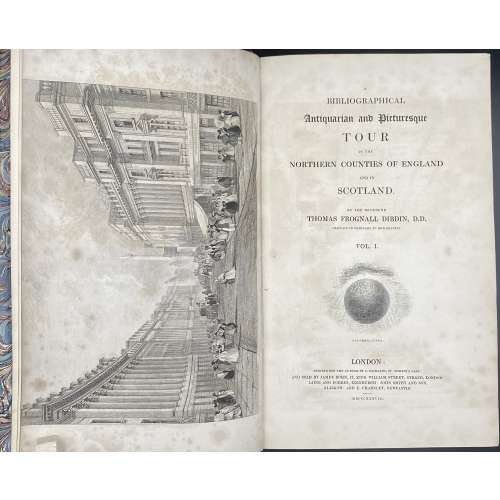 Vol. 1: A | BIBLIOGRAPHICAL | Antiquarian and Picturesque | TOUR | IN THE | NORTHERN COUNTIES OF ENGLAND | AND IN | SCOTLAND. | BY THE REVEREND | THOMAS FROGNALL DIBDIN, D.D. | CHAPLAIN IN ORDINARY TO HER MAJESTY. | VOL. I. |{device} motto: DEI OMNIA PLENA | LONDON: | PRINTED FOR THE AUTHOR BY C. RICHARDS, ST. MARTIN’S LANE : | AND SOLD BY JAMES BOHN, 12 KING WILLIAM STREET, STRAND, LONDON : | LAING AND FORBES, EDINBURGH : JOHN SMITH AND SON, | GLASGOW : AND E. CHARNLEY, NEWCASTLE. | MDCCCXXXVIII.|| Pagination: ffl, frontispiece by W. Douglas after T. M. Richardson, [i-ii] t.p. / blank; [iii-iv] - dedication to Frances Mary Richardson Currer (British, 1785 – 1861) / blank, [v] vi-xv – preface, [i] ii-xxx – supplement & index, [2] – corrections / colophon, [2] list of plates, [2] – contents, [1] 2-436, bfl; 11 plates extraneous to collation (incl. frontis.), lacking one plate (facing p. 213. “Thos. Bridges…”), in-text woodcut vignettes, head- and tailpieces. Collation: 8vo; π8 a-b8 [c2] B-Z8 2A-2E8 2F2. Vol. 2: Similar title but "VOL. II." Pagination: ffl, frontispiece portrait of Hugh Stewart, Aged 84 by Robert Bell after Alison (nothing known); [2] – t.p. / blank, [2] – contents / cont., [437-8] f.t. / blank [439] 440-1090, bfl; 453/4 misprinted 449/50; lacking list of subscribers. Collation: 8vo; π2 [2F3-2F6] 2G-2Z8 3A-3Z8. Binding: By J. Leighton, Brewer Street. Later half dark brown morocco over marbled boards, raised bands with gilt fillets, gilt titling and fillets in compartments, all edges gilt, marbled endpapers. Edition: 1st edition of Dibdin’s last major work and the only edition of this title. Size: 24.5 x 15.5 cm Provenance: Lord Ronald Gower (British, 1845 – 1916); Frank Hird (British, 1873 – 1937). Catalogue raisonné: Jackson 89; Windle & Pippin A65, pp. 179–188 [LIB-2669.2021]. Artists: Abraham, [I.] Frederic Henry (British, 1790 – 1845) Carmichael, James John Wilson (British, 1800 – 1868) Geikie, Walter (British, 1795 – 1837) Harraden, Richard Bankes (British, 1778 – 1862) Hill, David Octavius (British, 1802 –1870) McLea, John Watson (British, fl.1832-1861) Nixon, James Henry (British, b. c. 1808) Reynolds, Sir Joshua (British, 1723 – 1792) Richardson, Thomas Miles (British, 1784 – 1848) Scott, J. (British, fl. 19th c.) Wilkinson, T. M. (British, fl. 19th c.) Engravers: Aikman, Alison [spouse of George Aikman?] (British, 1788 – 1865) Bell, Robert Charles (British, 1806 – 1872) Byfield, Mary (British, 1794/5 – 1871) Douglas, William (British, 1780 – 1832) Harraden, F. (British, fl. 1838) Horsburgh, John (British, 1791 –1869) Johnstone, John (British, fl. 1835 – ) Leith & Smith, Lithogrs (Edinburgh) Lizars, William Home (British, 1788 – 1859) Miller, William (British, 1796 – 1882) Penny, William (British, fl. 19th c.) Prior, Thomas Abiel (British, 1809 – 1886) Robinson, H. (British, fl. 19th c.) Smith, Charles John (British, 1803 – 1838) Thomson, James (British, 1788 – 1850)
Vol. 1: A | BIBLIOGRAPHICAL | Antiquarian and Picturesque | TOUR | IN THE | NORTHERN COUNTIES OF ENGLAND | AND IN | SCOTLAND. | BY THE REVEREND | THOMAS FROGNALL DIBDIN, D.D. | CHAPLAIN IN ORDINARY TO HER MAJESTY. | VOL. I. |{device} motto: DEI OMNIA PLENA | LONDON: | PRINTED FOR THE AUTHOR BY C. RICHARDS, ST. MARTIN’S LANE : | AND SOLD BY JAMES BOHN, 12 KING WILLIAM STREET, STRAND, LONDON : | LAING AND FORBES, EDINBURGH : JOHN SMITH AND SON, | GLASGOW : AND E. CHARNLEY, NEWCASTLE. | MDCCCXXXVIII.|| Pagination: ffl, frontispiece by W. Douglas after T. M. Richardson, [i-ii] t.p. / blank; [iii-iv] - dedication to Frances Mary Richardson Currer (British, 1785 – 1861) / blank, [v] vi-xv – preface, [i] ii-xxx – supplement & index, [2] – corrections / colophon, [2] list of plates, [2] – contents, [1] 2-436, bfl; 11 plates extraneous to collation (incl. frontis.), lacking one plate (facing p. 213. “Thos. Bridges…”), in-text woodcut vignettes, head- and tailpieces. Collation: 8vo; π8 a-b8 [c2] B-Z8 2A-2E8 2F2. Vol. 2: Similar title but "VOL. II." Pagination: ffl, frontispiece portrait of Hugh Stewart, Aged 84 by Robert Bell after Alison (nothing known); [2] – t.p. / blank, [2] – contents / cont., [437-8] f.t. / blank [439] 440-1090, bfl; 453/4 misprinted 449/50; lacking list of subscribers. Collation: 8vo; π2 [2F3-2F6] 2G-2Z8 3A-3Z8. Binding: By J. Leighton, Brewer Street. Later half dark brown morocco over marbled boards, raised bands with gilt fillets, gilt titling and fillets in compartments, all edges gilt, marbled endpapers. Edition: 1st edition of Dibdin’s last major work and the only edition of this title. Size: 24.5 x 15.5 cm Provenance: Lord Ronald Gower (British, 1845 – 1916); Frank Hird (British, 1873 – 1937). Catalogue raisonné: Jackson 89; Windle & Pippin A65, pp. 179–188 [LIB-2669.2021]. Artists: Abraham, [I.] Frederic Henry (British, 1790 – 1845) Carmichael, James John Wilson (British, 1800 – 1868) Geikie, Walter (British, 1795 – 1837) Harraden, Richard Bankes (British, 1778 – 1862) Hill, David Octavius (British, 1802 –1870) McLea, John Watson (British, fl.1832-1861) Nixon, James Henry (British, b. c. 1808) Reynolds, Sir Joshua (British, 1723 – 1792) Richardson, Thomas Miles (British, 1784 – 1848) Scott, J. (British, fl. 19th c.) Wilkinson, T. M. (British, fl. 19th c.) Engravers: Aikman, Alison [spouse of George Aikman?] (British, 1788 – 1865) Bell, Robert Charles (British, 1806 – 1872) Byfield, Mary (British, 1794/5 – 1871) Douglas, William (British, 1780 – 1832) Harraden, F. (British, fl. 1838) Horsburgh, John (British, 1791 –1869) Johnstone, John (British, fl. 1835 – ) Leith & Smith, Lithogrs (Edinburgh) Lizars, William Home (British, 1788 – 1859) Miller, William (British, 1796 – 1882) Penny, William (British, fl. 19th c.) Prior, Thomas Abiel (British, 1809 – 1886) Robinson, H. (British, fl. 19th c.) Smith, Charles John (British, 1803 – 1838) Thomson, James (British, 1788 – 1850) -
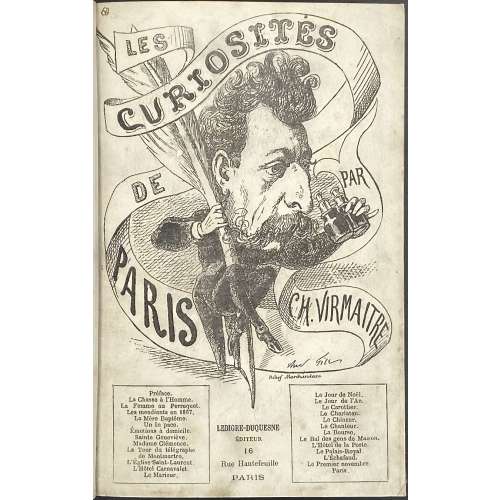 Title: LES | CURIOSITÉS DE PARIS | PAR | CH. VIRMAITRE | PRÉFACE DE M. XAVIER EYMA | PARIS | P. LEBIGRE-DUQUESNE, LIBRAIRE-ÉDITEUR | 16, RUE HAUTEFEUILLE, 16 | 1868 || Collation: 18mo, π6; 1-1918. Pagination: [2] – pictorial title by A. Gill, engr. Marchandeau / blank, [2] – t.p. / blank, [2] dedication to Émile de Girardin / blank, [vii] viii-xii – préface; [1] 2-360, bfl. Note: pp. 223/224 and XIX chapter’s f.t. unpaginated and loose, but collation is not interrupted. Other chapters f.t. paginated. Binding: hardcover, quarter brown buckram over marbled boards, flat spine, gilt fillets, gilt lettering over the black label. Contributors: Charles Virmaître (1835 – 1903) – text. Xavier Eyma (1816 – 1876) – text / preface. André Gill (French, 1840 – 1885) – artist / pictorial title. Marchandeau (French, fl. c. 1867) – engraver / pictorial title.
Title: LES | CURIOSITÉS DE PARIS | PAR | CH. VIRMAITRE | PRÉFACE DE M. XAVIER EYMA | PARIS | P. LEBIGRE-DUQUESNE, LIBRAIRE-ÉDITEUR | 16, RUE HAUTEFEUILLE, 16 | 1868 || Collation: 18mo, π6; 1-1918. Pagination: [2] – pictorial title by A. Gill, engr. Marchandeau / blank, [2] – t.p. / blank, [2] dedication to Émile de Girardin / blank, [vii] viii-xii – préface; [1] 2-360, bfl. Note: pp. 223/224 and XIX chapter’s f.t. unpaginated and loose, but collation is not interrupted. Other chapters f.t. paginated. Binding: hardcover, quarter brown buckram over marbled boards, flat spine, gilt fillets, gilt lettering over the black label. Contributors: Charles Virmaître (1835 – 1903) – text. Xavier Eyma (1816 – 1876) – text / preface. André Gill (French, 1840 – 1885) – artist / pictorial title. Marchandeau (French, fl. c. 1867) – engraver / pictorial title. -
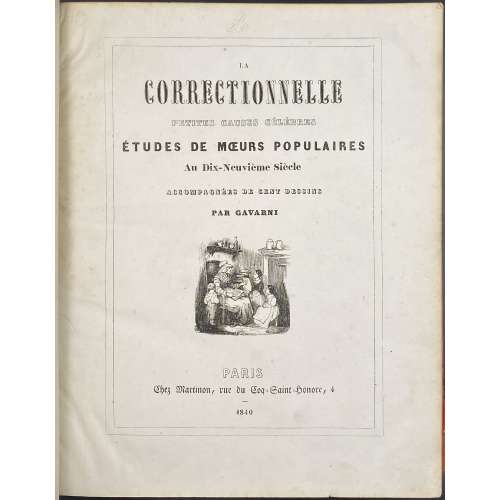 Title-page: LA | CORRECTIONNELLE | PETITES CAUSES CÉLÈBRES | ÉTUDES DE MŒURS POPULAIRES | Au Dix-Neuvième Siècle | ACCOMPAGNÉES DE CENT DESSINS | PAR GAVARNI | {woodcut vignette} | PARIS | Chez Martinon, rue du Coq-Saint-Honoré, 4 | 1840 || Collation: 2o, π3 (t.p. (wrapper?), h.t., t.p.), 1-1012; 205 leaves total, of them 100 plates, lithographs by Gavarni. Pagination: [6] [1] 2-403 [404], 410 pages total, incl. ils. (BnF calls for 426 pages total). Note: plate № 8 is numbered 9, plate № 9 numbered 8; p. 266 numbered 264, p. 268 numbered 266, p. 362 numbered 374, p. 364 numbered 376 (as called for by Carteret). Binding: “Romantique” publisher's quarter calf with gilt lettering and design elements over red paper boards, marbled endpapers. Complete 100 issues of the 4-page “La Correctionnelle” with a woodcut vignette after Gavarni on the 1st page of each issue, published between December 1839 and December 1840, and collected under one cover in 1840 by Martinon. Catalogue raisonné: Carteret (Le trésor, 1927): pp. 177-8; Brivois (1883): p.112. Both authors marked the edition as «rare in good condition". Gavarni [Sulpice Guillaume Chevalier] (French, 1804 – 1866) – artist. Amedée Gratiot et Cie. – printer, text. Coulon et Cie.– printer, lithographs. Coulon, Barthélémy Henry (French, fl. 1839 – ?)
Title-page: LA | CORRECTIONNELLE | PETITES CAUSES CÉLÈBRES | ÉTUDES DE MŒURS POPULAIRES | Au Dix-Neuvième Siècle | ACCOMPAGNÉES DE CENT DESSINS | PAR GAVARNI | {woodcut vignette} | PARIS | Chez Martinon, rue du Coq-Saint-Honoré, 4 | 1840 || Collation: 2o, π3 (t.p. (wrapper?), h.t., t.p.), 1-1012; 205 leaves total, of them 100 plates, lithographs by Gavarni. Pagination: [6] [1] 2-403 [404], 410 pages total, incl. ils. (BnF calls for 426 pages total). Note: plate № 8 is numbered 9, plate № 9 numbered 8; p. 266 numbered 264, p. 268 numbered 266, p. 362 numbered 374, p. 364 numbered 376 (as called for by Carteret). Binding: “Romantique” publisher's quarter calf with gilt lettering and design elements over red paper boards, marbled endpapers. Complete 100 issues of the 4-page “La Correctionnelle” with a woodcut vignette after Gavarni on the 1st page of each issue, published between December 1839 and December 1840, and collected under one cover in 1840 by Martinon. Catalogue raisonné: Carteret (Le trésor, 1927): pp. 177-8; Brivois (1883): p.112. Both authors marked the edition as «rare in good condition". Gavarni [Sulpice Guillaume Chevalier] (French, 1804 – 1866) – artist. Amedée Gratiot et Cie. – printer, text. Coulon et Cie.– printer, lithographs. Coulon, Barthélémy Henry (French, fl. 1839 – ?) -
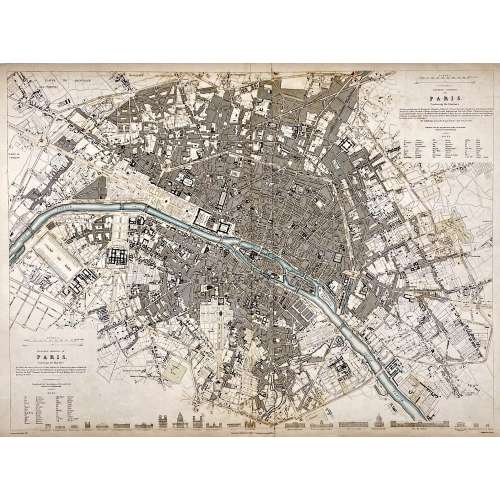 Top right: EASTERN DIVISION OF | PARIS. | Containing the Quartiers | {5 lines in italic} | Published under the Superintendence of the Society for the | Diffusion of Useful Knowledge || Bottom left: WESTERN DIVISION OF | PARIS. | Containing the Quartiers | {4 lines in italic} | Published under the Superintendence of the Society for the | Diffusion of Useful Knowledge || Under the frame: Drawn by W. B. Clarke, Archt. […] Published by Baldwin & Cradock, 47 Paternoster Row, A April 1st, 1834. [...] Engraved by J. Shury || Dimensions: Sheet: 40.8 x 57 cm; Image: 38.7 x 52.5 cm. Contributors: William Barnard Clarke (British, 1806 – 1865) – artist. John Shury (fl. c. 1814-1844) – engraver. Baldwin & Cradock (London) – publisher. Society for the Diffusion of Useful Knowledge (SDUK) (British firm, 1826 – 1846).
Top right: EASTERN DIVISION OF | PARIS. | Containing the Quartiers | {5 lines in italic} | Published under the Superintendence of the Society for the | Diffusion of Useful Knowledge || Bottom left: WESTERN DIVISION OF | PARIS. | Containing the Quartiers | {4 lines in italic} | Published under the Superintendence of the Society for the | Diffusion of Useful Knowledge || Under the frame: Drawn by W. B. Clarke, Archt. […] Published by Baldwin & Cradock, 47 Paternoster Row, A April 1st, 1834. [...] Engraved by J. Shury || Dimensions: Sheet: 40.8 x 57 cm; Image: 38.7 x 52.5 cm. Contributors: William Barnard Clarke (British, 1806 – 1865) – artist. John Shury (fl. c. 1814-1844) – engraver. Baldwin & Cradock (London) – publisher. Society for the Diffusion of Useful Knowledge (SDUK) (British firm, 1826 – 1846). -
 Kabuki actor: Matsumoto Kōshirō V [五代目松本幸四郎] (Japanese, 1764-1838); other names: Ichikawa Komazō III, Ichikawa Sumizō I. Role: Nikki Danjo (仁木弾正): "Evil retainer Nikki Danjo who plots to overthrow his lord in the play Precious incense and the bush clover of Sendai (Meiboku sendai hagi)" [R. Kruml]. Artist: Utagawa Kunisada [歌川 国貞] a.k.a. Utagawa Toyokuni III [三代歌川豊国] (Japanese, 1786 – 1865). Block cutter: Horikō (Kiyomizu) Ryūzō [彫工 柳三]. Publisher: Ebisuya Shoshichi [恵比寿屋庄七], Kinshōdō (Japanese, fl. c. 1846 – 1883). Year: 1863 (Bunkyū 3), 7th month. Size: Vertical ōban, hōsho paper. Signed: Nanajuhassai (aged seventy-eight) Toyokuni ga within toshidama cartouche. Censor’s seal: date-aratame. This print is from a series of portraits that Kunisada undertook very late in life and has been named Kinshodo-ban yakusha okubi-e (Kinshodo’s Large-Head Actor Portraits) in reference to the publisher, Ebisuya Shochochi of Kinshodo. The series depicted great actors in their famous roles from the past and present. Ref.: (1) [LIB-1212.2017] Robert Schaap. Kunisada: Imaging, drama and beauty. — Leiden: Hotei Publishing, 2016, p. 118 and 167 (№ 42):
Kabuki actor: Matsumoto Kōshirō V [五代目松本幸四郎] (Japanese, 1764-1838); other names: Ichikawa Komazō III, Ichikawa Sumizō I. Role: Nikki Danjo (仁木弾正): "Evil retainer Nikki Danjo who plots to overthrow his lord in the play Precious incense and the bush clover of Sendai (Meiboku sendai hagi)" [R. Kruml]. Artist: Utagawa Kunisada [歌川 国貞] a.k.a. Utagawa Toyokuni III [三代歌川豊国] (Japanese, 1786 – 1865). Block cutter: Horikō (Kiyomizu) Ryūzō [彫工 柳三]. Publisher: Ebisuya Shoshichi [恵比寿屋庄七], Kinshōdō (Japanese, fl. c. 1846 – 1883). Year: 1863 (Bunkyū 3), 7th month. Size: Vertical ōban, hōsho paper. Signed: Nanajuhassai (aged seventy-eight) Toyokuni ga within toshidama cartouche. Censor’s seal: date-aratame. This print is from a series of portraits that Kunisada undertook very late in life and has been named Kinshodo-ban yakusha okubi-e (Kinshodo’s Large-Head Actor Portraits) in reference to the publisher, Ebisuya Shochochi of Kinshodo. The series depicted great actors in their famous roles from the past and present. Ref.: (1) [LIB-1212.2017] Robert Schaap. Kunisada: Imaging, drama and beauty. — Leiden: Hotei Publishing, 2016, p. 118 and 167 (№ 42): Ref.: (1) [LIB-1197.2016] Arendie and Henk Herwig. Heroes of the kabuki stage: an introduction to kabuki with retellings of famous plays, illustrated by woodblock prints. — Amsterdam: Hotei Publishing, 2004; pp. 243-249.
Ref.: (1) [LIB-1197.2016] Arendie and Henk Herwig. Heroes of the kabuki stage: an introduction to kabuki with retellings of famous plays, illustrated by woodblock prints. — Amsterdam: Hotei Publishing, 2004; pp. 243-249.


-
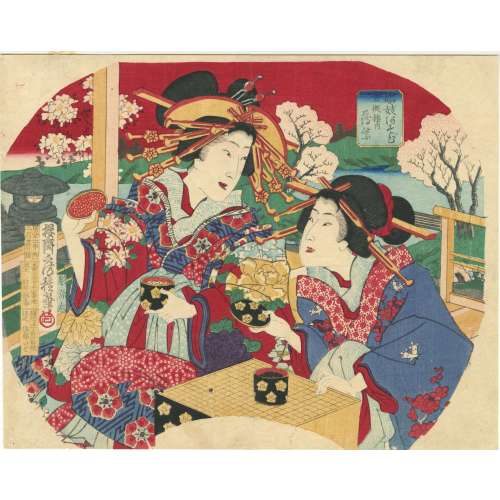 Artist: Utagawa Fusatane [歌川 房種] (Japanese, fl. 1854 – 1889), other names: Ippyosai; Isshosai; Murai Seima; Utagawa Seimas; Osai; Signed: Ōsai Fusatane Hitsu [桜斎房種筆] in a cartouche, with a round stamp. Block carver: Watanabe Yatarō (Japanese, 1850 – 1913); seal [彫弥太] – Hori Yata (Friese 2009b: 117). Publisher [板元] (Hammoto): Satō Ise [佐藤いせ], address: Horiechō, Nichōme, ichi-banchi [堀江町二丁目一番地] Publication date [御届] (otodoke): Meiji 10th year, 3rd month, 22nd day (1877). Artist [画工] (Gakō): Murai Seima [村井 静馬], address: Honjo-Sotodechō, 18 [本所外手丁十八番地]. Uncut fan print (uchiwa-e), 236 x 297 mm, depicting two harlots or courtesans playing [娼妓あそび] (shōgi asobi) go game in the famous Kinpeiro [金瓶楼内] brothel in New Yoshiwara in Tokyo. In the courtesan's name, the second character seems to be 紫 (Murasaki); the first character is unclear, so we do not know her name yet.
Artist: Utagawa Fusatane [歌川 房種] (Japanese, fl. 1854 – 1889), other names: Ippyosai; Isshosai; Murai Seima; Utagawa Seimas; Osai; Signed: Ōsai Fusatane Hitsu [桜斎房種筆] in a cartouche, with a round stamp. Block carver: Watanabe Yatarō (Japanese, 1850 – 1913); seal [彫弥太] – Hori Yata (Friese 2009b: 117). Publisher [板元] (Hammoto): Satō Ise [佐藤いせ], address: Horiechō, Nichōme, ichi-banchi [堀江町二丁目一番地] Publication date [御届] (otodoke): Meiji 10th year, 3rd month, 22nd day (1877). Artist [画工] (Gakō): Murai Seima [村井 静馬], address: Honjo-Sotodechō, 18 [本所外手丁十八番地]. Uncut fan print (uchiwa-e), 236 x 297 mm, depicting two harlots or courtesans playing [娼妓あそび] (shōgi asobi) go game in the famous Kinpeiro [金瓶楼内] brothel in New Yoshiwara in Tokyo. In the courtesan's name, the second character seems to be 紫 (Murasaki); the first character is unclear, so we do not know her name yet. -
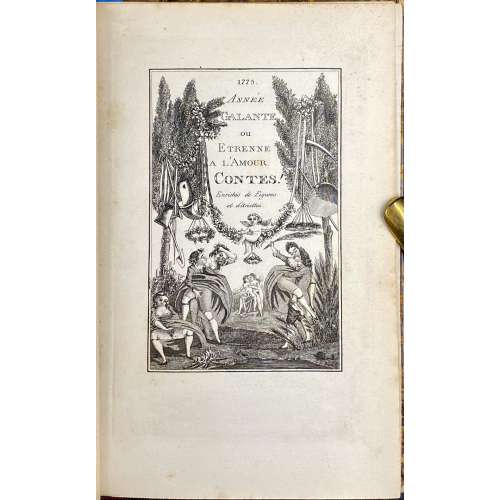 Single volume, 20 x 13 cm, quarter brown morocco over marbled boards tooled in gilt, spine with raised bands, gilt in compartments, and gilt lettering, marbled endpapers, printed on wove paper on recto with verso blank, collated 1-48; total 32 leaves, 11 torn off, 47,8 blanks, ; uneven pagination [1] 2-41 [4 blanks], plus engraved title-page and 12 engraved half-page plates with text, uncoloured, by Louis Jaugey (unsigned), one for each month. Title-page (engraved): vignette with lettering "1775. ANNÉE | GALANTE | OU | ETRENNE | A L'AMOUR | CONTES! | Enrichis de Figures | et d'Ariettes. ||" Catalogue raisonné: Dutel I: A-82. Catalogue Poulet-Malassis & ses amis description: № 68. [Auteur inconnu]. Année galante ou Etrenne à l’amour. Contes, enrichis de Figures et d’Ariees. [Vital Puissant, Bruxelles, 1876 ?] 1775. In-8, 3 .n.ch., 29 . imprimés au recto, chirés de 2 à 41, demi-chagrin brun, dos à nerfs orné, let doré sur les mors, tête et tranches jaspées (reliure ancienne). Illustrée de 13 planches dont l’une en frontispice par Louis Jaugey. Les figures sont à mi-page, une pour chaque mois. Contributors: Louis Jaugey (French, fl. 1871 – 1876) – artist. Vital Puissant (Belgian, 1835 – 1878) – publisher.
Single volume, 20 x 13 cm, quarter brown morocco over marbled boards tooled in gilt, spine with raised bands, gilt in compartments, and gilt lettering, marbled endpapers, printed on wove paper on recto with verso blank, collated 1-48; total 32 leaves, 11 torn off, 47,8 blanks, ; uneven pagination [1] 2-41 [4 blanks], plus engraved title-page and 12 engraved half-page plates with text, uncoloured, by Louis Jaugey (unsigned), one for each month. Title-page (engraved): vignette with lettering "1775. ANNÉE | GALANTE | OU | ETRENNE | A L'AMOUR | CONTES! | Enrichis de Figures | et d'Ariettes. ||" Catalogue raisonné: Dutel I: A-82. Catalogue Poulet-Malassis & ses amis description: № 68. [Auteur inconnu]. Année galante ou Etrenne à l’amour. Contes, enrichis de Figures et d’Ariees. [Vital Puissant, Bruxelles, 1876 ?] 1775. In-8, 3 .n.ch., 29 . imprimés au recto, chirés de 2 à 41, demi-chagrin brun, dos à nerfs orné, let doré sur les mors, tête et tranches jaspées (reliure ancienne). Illustrée de 13 planches dont l’une en frontispice par Louis Jaugey. Les figures sont à mi-page, une pour chaque mois. Contributors: Louis Jaugey (French, fl. 1871 – 1876) – artist. Vital Puissant (Belgian, 1835 – 1878) – publisher. -
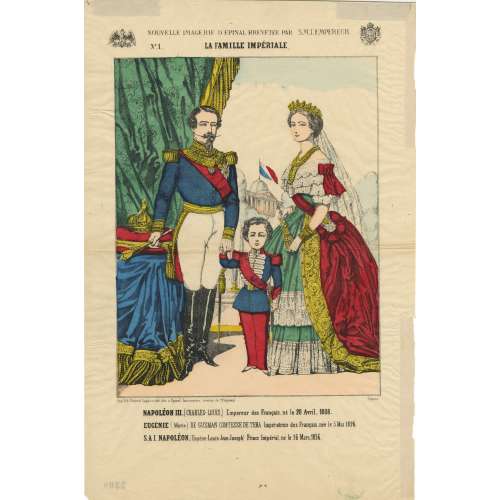 Hand-coloured woodcut on wove paper, 390 x 260 mm; black ink stamp “5308” to reverse; horizontal centerfold. Centre top: "NOUVELLE IMAGERIE D'ÉPINAL BREVETÉE PAR S.M.L’EMPEREUR" with imperial eagle and coat of arms at right and left. Below: "№ 1." — "LA FAMILLE IMPÉRIALE"; image in frame; under the image, left: "Imp lith. Pinot & Sagaire, édit. libr. à Épinal, fournisseurs brevetés de l’Empereur"; right: "Déposé". Bottom: "NAPOLÉON I. (CHARLES-LOUIS,) Empereur des Français, né le 20 Avril, 1808. | EUGÉNIE ( Marie) DE GUSMAN COMTESSE DE TEBA Impératrice des Français, née le 5 Mai 1826. | S.A I. NAPOLÉON. (Eugène-Louis-Jean-Joseph) Prince Impérial, ne le 16 Mars. 1856." Napoleon III [Charles-Louis Napoléon Bonaparte] (French, 1808 – 1873) Eugénie de Montijo [L'impératrice Eugénie] (Spanish-French, 1826 – 1920) Napoléon, Prince Imperial (Napoléon Eugène Louis Jean Joseph Bonaparte] (French, 1856 – 1879) Pinot & Sagaire (Épinal, 1861 – 1888) – enterprise, publisher/printer. Charles-François Pinot (French, 1817 – 1879) – publisher/printer.
Hand-coloured woodcut on wove paper, 390 x 260 mm; black ink stamp “5308” to reverse; horizontal centerfold. Centre top: "NOUVELLE IMAGERIE D'ÉPINAL BREVETÉE PAR S.M.L’EMPEREUR" with imperial eagle and coat of arms at right and left. Below: "№ 1." — "LA FAMILLE IMPÉRIALE"; image in frame; under the image, left: "Imp lith. Pinot & Sagaire, édit. libr. à Épinal, fournisseurs brevetés de l’Empereur"; right: "Déposé". Bottom: "NAPOLÉON I. (CHARLES-LOUIS,) Empereur des Français, né le 20 Avril, 1808. | EUGÉNIE ( Marie) DE GUSMAN COMTESSE DE TEBA Impératrice des Français, née le 5 Mai 1826. | S.A I. NAPOLÉON. (Eugène-Louis-Jean-Joseph) Prince Impérial, ne le 16 Mars. 1856." Napoleon III [Charles-Louis Napoléon Bonaparte] (French, 1808 – 1873) Eugénie de Montijo [L'impératrice Eugénie] (Spanish-French, 1826 – 1920) Napoléon, Prince Imperial (Napoléon Eugène Louis Jean Joseph Bonaparte] (French, 1856 – 1879) Pinot & Sagaire (Épinal, 1861 – 1888) – enterprise, publisher/printer. Charles-François Pinot (French, 1817 – 1879) – publisher/printer. -

Поль Дельтуф. Жизнь и творения Макиавелли. // "Записки для чтения, издаваемые К. Трубниковым", 1867, NN 8-9, с. 73-77. Ежемесячное приложение к Биржевым ведомостям. Август и Сентябрь. Санктпетербург. Тип. Товарищества "Общественная польза".
"Essai sur les oeuvres et la doctrine de Machiavel, avec la traduction littérale du Prince et de quelques fragments historiques et littéraires", par Paul Deltuf, Paris, 1867.
-
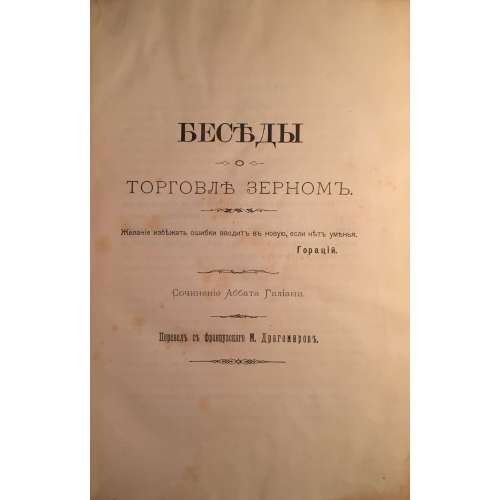
Беседы о торговле зерном. Сочинение аббата Галиани. Перевел с французского М. Драгомиров. — [Киев]: [тип. Окр. Штаба], [1891]. — [4], III, [3], 210, XXII стр. Примечание: Доб. тит. л. на фр. яз.: Dialogues sur le commerce des bleds. — A Londres, MDCCLXX.
-
 Shibuichi Kozuka carved in low relief (takabori, usuniku-bori) and inlaid in gold and silver with design of Shoko, reading by moonlight, thatch, pine rosettes, and fool moon. According to Henri L. Joly [LEGEND IN JAPANESE ART. London, 1908; LIB-1416 in this collection] Shoko was a Chinese student of Taoism who was so poor that he had no money to buy illuminating materials and read by moonlight. Shoko mentioned in the article about another Chinese character - Shaen, who was reading by the light emitted by glow-worms (see page 310). Signed on the back: Haruchika (春親) + kaō. Size: 97.3 mm (H) x 14.8 mm (W). Edo period, mid 19th century. NBTHK Certificate № 449542. Hamano Haruchika from Edo was a student of Haruyuki in 1848-54; Hamano School, Etchū Toyama Branch, according to M. Sesko's "Genealogy", page. 34. Most probably it is his work. Following the MFA data, it is also possible that "our" Haruchika is indeed Nara Haruchika or Tsuchiya Haruchika from Nara School; though I did not hind such artist in Markus Sesko books. However, in his "Toso-Kinko" on page 177 there is certain Shingorō who carried out his business under the name of Yanagawa Haruchika (1791-1857?)
Shibuichi Kozuka carved in low relief (takabori, usuniku-bori) and inlaid in gold and silver with design of Shoko, reading by moonlight, thatch, pine rosettes, and fool moon. According to Henri L. Joly [LEGEND IN JAPANESE ART. London, 1908; LIB-1416 in this collection] Shoko was a Chinese student of Taoism who was so poor that he had no money to buy illuminating materials and read by moonlight. Shoko mentioned in the article about another Chinese character - Shaen, who was reading by the light emitted by glow-worms (see page 310). Signed on the back: Haruchika (春親) + kaō. Size: 97.3 mm (H) x 14.8 mm (W). Edo period, mid 19th century. NBTHK Certificate № 449542. Hamano Haruchika from Edo was a student of Haruyuki in 1848-54; Hamano School, Etchū Toyama Branch, according to M. Sesko's "Genealogy", page. 34. Most probably it is his work. Following the MFA data, it is also possible that "our" Haruchika is indeed Nara Haruchika or Tsuchiya Haruchika from Nara School; though I did not hind such artist in Markus Sesko books. However, in his "Toso-Kinko" on page 177 there is certain Shingorō who carried out his business under the name of Yanagawa Haruchika (1791-1857?) -
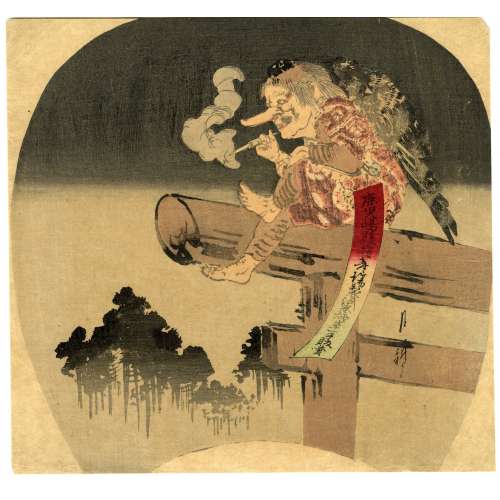 Ogata Gekkō [尾形月耕] (Japanese, 1859 – 1920). An uchiwa-e (fan-print) of advertisement of tobacco of Kagoshima Prefecture, c. 1890 (Meiji Period). Barefoot Tengu* is sitting on a torii (entrance to a Shinto shrine), smoking a cigarette through a mouthpiece. _______ * Tengu [天狗] (heavenly dog) is a type of legendary creature found in Japanese folk religion and are also considered a type of Shinto god (kami) or yōkai (supernatural beings).
Ogata Gekkō [尾形月耕] (Japanese, 1859 – 1920). An uchiwa-e (fan-print) of advertisement of tobacco of Kagoshima Prefecture, c. 1890 (Meiji Period). Barefoot Tengu* is sitting on a torii (entrance to a Shinto shrine), smoking a cigarette through a mouthpiece. _______ * Tengu [天狗] (heavenly dog) is a type of legendary creature found in Japanese folk religion and are also considered a type of Shinto god (kami) or yōkai (supernatural beings). -
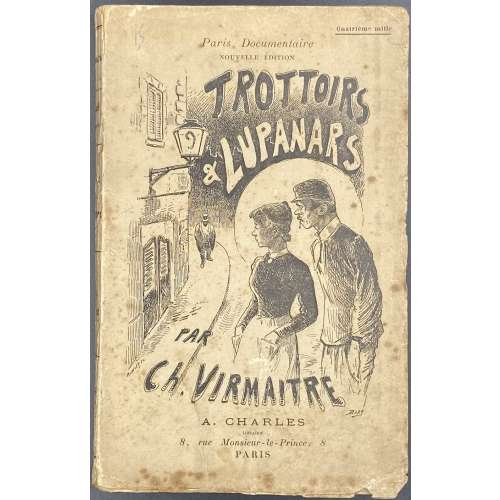 Front wrapper: Quatrième mille | Paris Documentaire | NOUVELLE ÉDITION | TROTTOIRS | ET | LUPANARS | PAR | Ch. VIRMAITRE | A. CHARLES | LIBRAIRE | 8, Rue Monsieur-le-Prince, 8 | PARIS || Title page: Ch. VIRMAITRE | PARIS DOCUMENTAIRE | (Mœurs) | TROTTOIRS | ET | LUPANARS | {fleuron} | A. CHARLES | LIBRAIRE | 8, Rue Monsieur-le-Prince, 8 | PARIS | 1897 || Collation: 18mo; Front pictorial wrapper, 2 ffls, π4, 118, 318, 518, 718, 918, 1118, 1318, 1514, back pictorial wrapper (portrait) Pagination: [1-7] 8-282 [6]. Binding: Publisher’s pictorial wrappers, lettering to spine. Charles Virmaître (French, 1835 – 1903).
Front wrapper: Quatrième mille | Paris Documentaire | NOUVELLE ÉDITION | TROTTOIRS | ET | LUPANARS | PAR | Ch. VIRMAITRE | A. CHARLES | LIBRAIRE | 8, Rue Monsieur-le-Prince, 8 | PARIS || Title page: Ch. VIRMAITRE | PARIS DOCUMENTAIRE | (Mœurs) | TROTTOIRS | ET | LUPANARS | {fleuron} | A. CHARLES | LIBRAIRE | 8, Rue Monsieur-le-Prince, 8 | PARIS | 1897 || Collation: 18mo; Front pictorial wrapper, 2 ffls, π4, 118, 318, 518, 718, 918, 1118, 1318, 1514, back pictorial wrapper (portrait) Pagination: [1-7] 8-282 [6]. Binding: Publisher’s pictorial wrappers, lettering to spine. Charles Virmaître (French, 1835 – 1903). -
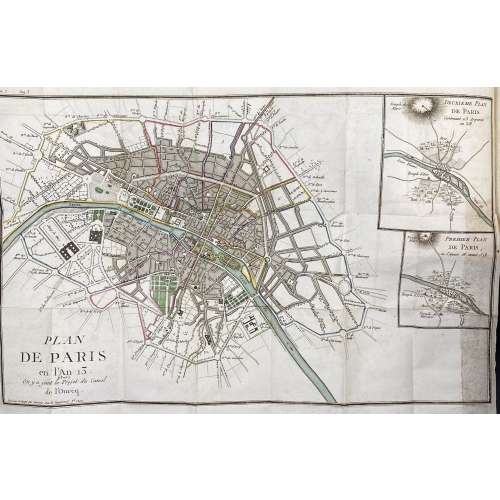 Two volumes, 12mo; 14 x 9 cm, uniformly bound in speckled calf with dentelle border in gilt, gilt-stamped spine with two crimson lettered labels, marbled endpapers. Inscription to h.t.: P. Leigh Smith | Moscow | 1921 || Vol. 1: Half-title: MIROIR | DE L'ANCIEN ET DU NOUVEAU | PARIS, | AVEC TREIZE VOYAGES | EN VÉLOCIFÈRES, |DANS SES ENVIRONS. | TOME I. || Title page: MIROIR | DE L'ANCIEN ET DU NOUVEAU | PARIS, | AVEC TREIZE VOYAGES | EN VÉLOCIFÈRES, |DANS SES ENVIRONS. Ouvrage indespensable aus Étrangers et même | aux Parisiens, et qui indique tout ce qu’il faut | connoître et éviter dans cette capitale. | Orné d’un Plan de Paris et de 18 Gravures | {to the right, in single rules} Tels temps, telles mœurs. | Par L. Prudhomme. | Tome I. | PARIS, | PRUDHOMME, fils, rue des Marais, F. B. St.-G. | DEBRAY, rue St. Honoré, barrière des Sergens. | AN XIII. — (1804.) || Pagination: [i-vii] viii-xxxvi, 1-260; total 296 pages + 15 copperplate engravings and 1 folding plan of Paris. Collation: πA-πC6, A-C6, 4-216 224; total 148 leaves + 15 plates + 1 folding. Note: 12mo; πA1 unsigned, A2 unsigned, A–C3 signed A-C5, respectively, 4* unsigned, 9* marked 8*, 18* marked 17*. Vol. 2: Similar half-title and title, TOME II instead of TOME I. Pagination: [4] 1-408; total 412 pages + 3 copperplate engravings. Collation: π2, 1-346; total 206 leaves + 3 plates.
Two volumes, 12mo; 14 x 9 cm, uniformly bound in speckled calf with dentelle border in gilt, gilt-stamped spine with two crimson lettered labels, marbled endpapers. Inscription to h.t.: P. Leigh Smith | Moscow | 1921 || Vol. 1: Half-title: MIROIR | DE L'ANCIEN ET DU NOUVEAU | PARIS, | AVEC TREIZE VOYAGES | EN VÉLOCIFÈRES, |DANS SES ENVIRONS. | TOME I. || Title page: MIROIR | DE L'ANCIEN ET DU NOUVEAU | PARIS, | AVEC TREIZE VOYAGES | EN VÉLOCIFÈRES, |DANS SES ENVIRONS. Ouvrage indespensable aus Étrangers et même | aux Parisiens, et qui indique tout ce qu’il faut | connoître et éviter dans cette capitale. | Orné d’un Plan de Paris et de 18 Gravures | {to the right, in single rules} Tels temps, telles mœurs. | Par L. Prudhomme. | Tome I. | PARIS, | PRUDHOMME, fils, rue des Marais, F. B. St.-G. | DEBRAY, rue St. Honoré, barrière des Sergens. | AN XIII. — (1804.) || Pagination: [i-vii] viii-xxxvi, 1-260; total 296 pages + 15 copperplate engravings and 1 folding plan of Paris. Collation: πA-πC6, A-C6, 4-216 224; total 148 leaves + 15 plates + 1 folding. Note: 12mo; πA1 unsigned, A2 unsigned, A–C3 signed A-C5, respectively, 4* unsigned, 9* marked 8*, 18* marked 17*. Vol. 2: Similar half-title and title, TOME II instead of TOME I. Pagination: [4] 1-408; total 412 pages + 3 copperplate engravings. Collation: π2, 1-346; total 206 leaves + 3 plates. -
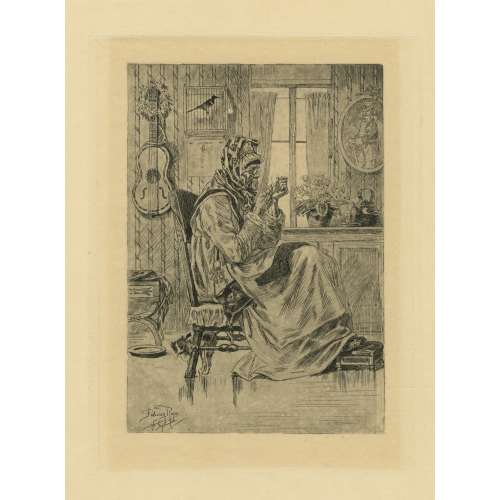
Etching on wove paper, depicting an old woman trying to thread a needle. Signed in plate: "Felicien Rops, 76 Septembre". Owner's stamp LvM on verso.
Dimensions: Paper: 51.9 x 35 cm; Plate: 27.5 x 21 cm; Image: 23.5 x 16 cm.
Catalogue raisonné: Arthur Hubschmid (1977): 358; Graphics irreverent and erotic (1968): 54.
-
 Artist: Utagawa Kuniyasu [歌川 国安] (Japanese, 1794–1832). Publisher seal: [太] (Ta): Marks 02-050 | U421b: An unknown publisher in Edo, fl. c. 1815-61; name assigned according to seal shape “Yama-Ta“. Signed: Kuniyasu ga [国安 画]. Date-aratame seal: Bunsei 9 (1826). Actors: Iwai Hanshirō VI [岩井半四郎] (Japanese, 1799 – 1836), other names: Iwai Hanshirō VI, Iwai Kumesaburō II, Iwai Hisajirō I, Baiga (poetry name), Shūka (poetry name) — as Shirai Gonpachi [白井權八]. Ichikawa Danjūrō VII 市川団十郎 (Japanese, 1791 – 1859), other names: Ichikawa Ebizō V, Ichikawa Hakuen II, Ichikawa Shinnosuke I — as Banzui Chōbei [幡随長兵衛]. Kabuki play: Suzugamori [Suzu-ga-Mori, 鈴ヶ森], a.k.a. Ukiyozuka Hiyoku no Inazuma written by Tsuruya Nanboku IV (Japanese, c. 1755 – 1829). First staged in 1823 at Ichimura-za [市村座] in Edo. Plot: "A gang of evil palanquin bearers are stationed near the Suzugamori execution grounds, where they lay in wait to rob travellers passing through. Gonpachi, who killed a man in his home province, is being sought by the police. He is fleeing to Edo when the bearers attack him in hopes of claiming a reward. He beats them off with great skill. Banzui Chōbei, who is being carried by in a palanquin, sees the attack, admires Gonpachi's ability, and promises to aid him if he is going to Edo". [Samuel L. Leiter. Historical Dictionary of Japanese Traditional Theatre. — Rowman & Littlefield, 2014; p. 382-3.; LIB-2110.2019]. Ref.: Sotheby's.
Artist: Utagawa Kuniyasu [歌川 国安] (Japanese, 1794–1832). Publisher seal: [太] (Ta): Marks 02-050 | U421b: An unknown publisher in Edo, fl. c. 1815-61; name assigned according to seal shape “Yama-Ta“. Signed: Kuniyasu ga [国安 画]. Date-aratame seal: Bunsei 9 (1826). Actors: Iwai Hanshirō VI [岩井半四郎] (Japanese, 1799 – 1836), other names: Iwai Hanshirō VI, Iwai Kumesaburō II, Iwai Hisajirō I, Baiga (poetry name), Shūka (poetry name) — as Shirai Gonpachi [白井權八]. Ichikawa Danjūrō VII 市川団十郎 (Japanese, 1791 – 1859), other names: Ichikawa Ebizō V, Ichikawa Hakuen II, Ichikawa Shinnosuke I — as Banzui Chōbei [幡随長兵衛]. Kabuki play: Suzugamori [Suzu-ga-Mori, 鈴ヶ森], a.k.a. Ukiyozuka Hiyoku no Inazuma written by Tsuruya Nanboku IV (Japanese, c. 1755 – 1829). First staged in 1823 at Ichimura-za [市村座] in Edo. Plot: "A gang of evil palanquin bearers are stationed near the Suzugamori execution grounds, where they lay in wait to rob travellers passing through. Gonpachi, who killed a man in his home province, is being sought by the police. He is fleeing to Edo when the bearers attack him in hopes of claiming a reward. He beats them off with great skill. Banzui Chōbei, who is being carried by in a palanquin, sees the attack, admires Gonpachi's ability, and promises to aid him if he is going to Edo". [Samuel L. Leiter. Historical Dictionary of Japanese Traditional Theatre. — Rowman & Littlefield, 2014; p. 382-3.; LIB-2110.2019]. Ref.: Sotheby's. -
 Artist: Utagawa Kunisada [歌川 国貞] a.k.a. Utagawa Toyokuni III [三代歌川豊国] (Japanese, 1786 – 1865). Signed: Ōju Toyokuni ga [応需豊国画] in a toshidama cartouche. Double nanushi censor seals Mera & Murata (1846-50). Publisher: Kojimaya Jūbei [小嶋屋重兵衛] (Japanese, fl. c. 1797 – 1869). A gentleman, probably a kabuki actor Nakamura Utaemon IV [中村歌右衛門] (Nakamura Shikan II, Nakamura Tsurusuke I, Nakamura Tōtarō, Japanese, 1796 – 1852) drinking tea on a veranda under the shining moon. Series Moon, Sun, Stars [月日星] (tsuki-hi-hoshi/boshi), the three sources of light (sankō) [三光]:
Artist: Utagawa Kunisada [歌川 国貞] a.k.a. Utagawa Toyokuni III [三代歌川豊国] (Japanese, 1786 – 1865). Signed: Ōju Toyokuni ga [応需豊国画] in a toshidama cartouche. Double nanushi censor seals Mera & Murata (1846-50). Publisher: Kojimaya Jūbei [小嶋屋重兵衛] (Japanese, fl. c. 1797 – 1869). A gentleman, probably a kabuki actor Nakamura Utaemon IV [中村歌右衛門] (Nakamura Shikan II, Nakamura Tsurusuke I, Nakamura Tōtarō, Japanese, 1796 – 1852) drinking tea on a veranda under the shining moon. Series Moon, Sun, Stars [月日星] (tsuki-hi-hoshi/boshi), the three sources of light (sankō) [三光]: -
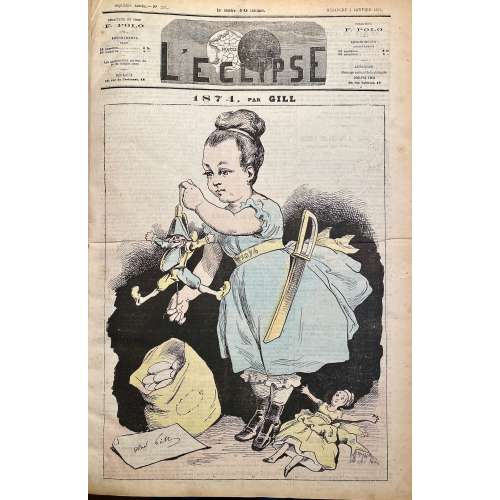 129 issues of L'Éclipse, French weekly political magazine; published in Paris, 49 x 34 cm, bound in rebacked green quarter morocco over marbled boards, with gilt fillets and lettering to spine, peacock marbled endpapers, illustrated by André Gill (French, 1840 – 1885). Founder and editor-in-chief François Polo (French, 1838 – 1874). 1874: 271-322 (52 issues) 1875: 323-374 (52 issues) 1876: 375-399 (25 issues)
129 issues of L'Éclipse, French weekly political magazine; published in Paris, 49 x 34 cm, bound in rebacked green quarter morocco over marbled boards, with gilt fillets and lettering to spine, peacock marbled endpapers, illustrated by André Gill (French, 1840 – 1885). Founder and editor-in-chief François Polo (French, 1838 – 1874). 1874: 271-322 (52 issues) 1875: 323-374 (52 issues) 1876: 375-399 (25 issues) -
 Artist: Utagawa Kuniyoshi [歌川 國芳] (1798 – 1861). A beauty leaning on a fence and watching a dragonfly hovering above a flowering plant. Signed: Ichiyûsai Kuniyoshi ga (一勇斎 國芳 画) in a double gourd-shaped red cartouche. Publisher: Maruya Jinpachi, seal Jin [甚] (Marks 08-088 | 294d). No date/censor seal. Media: Fan print (uchiwa-e, 団扇絵), 234 x 301 mm.
Artist: Utagawa Kuniyoshi [歌川 國芳] (1798 – 1861). A beauty leaning on a fence and watching a dragonfly hovering above a flowering plant. Signed: Ichiyûsai Kuniyoshi ga (一勇斎 國芳 画) in a double gourd-shaped red cartouche. Publisher: Maruya Jinpachi, seal Jin [甚] (Marks 08-088 | 294d). No date/censor seal. Media: Fan print (uchiwa-e, 団扇絵), 234 x 301 mm. -
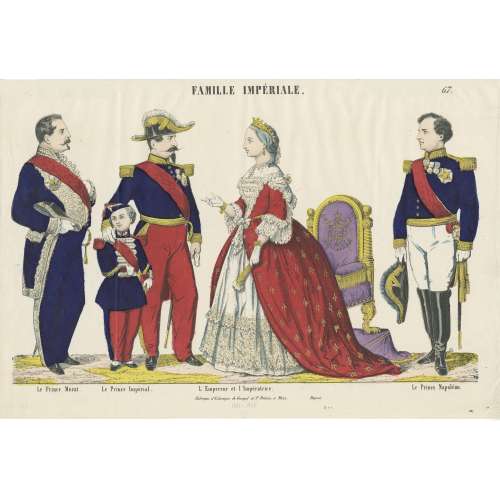 Hand-coloured woodcut on wove paper, 288 x 426 mm; black ink stamp “5305” to reverse. Top centre: "FAMILLE IMPÉRIALE", right: "67." Under the image: "Le Prince Murat." — "Le Prince Impérial." — "L' Empereur et l'Impératrice." — "Le Prince Napoléon." Bottom: "Fabrique d'Estampes de Gangel et P. Didion, à Metz." — "Déposé." Bottom: ms in pencil "1861 – 1868". Publisher/printer: Gangel et P. Didion (Metz); Paulin Didion (French, 1831 – 1879). Characters: Napoleon III [Charles-Louis Napoléon Bonaparte] (French, 1808 – 1873) Eugénie de Montijo [L'impératrice Eugénie] (Spanish-French, 1826 – 1920) Napoléon, Prince Imperial (Napoléon Eugène Louis Jean Joseph Bonaparte] (French, 1856 – 1879) Prince Murat [Lucien Charles Joseph Napoléon] (French, 1803 – 1878) Napoléon-Jérôme Bonaparte [Prince Napoléon] (French, 1822 – 1891)
Hand-coloured woodcut on wove paper, 288 x 426 mm; black ink stamp “5305” to reverse. Top centre: "FAMILLE IMPÉRIALE", right: "67." Under the image: "Le Prince Murat." — "Le Prince Impérial." — "L' Empereur et l'Impératrice." — "Le Prince Napoléon." Bottom: "Fabrique d'Estampes de Gangel et P. Didion, à Metz." — "Déposé." Bottom: ms in pencil "1861 – 1868". Publisher/printer: Gangel et P. Didion (Metz); Paulin Didion (French, 1831 – 1879). Characters: Napoleon III [Charles-Louis Napoléon Bonaparte] (French, 1808 – 1873) Eugénie de Montijo [L'impératrice Eugénie] (Spanish-French, 1826 – 1920) Napoléon, Prince Imperial (Napoléon Eugène Louis Jean Joseph Bonaparte] (French, 1856 – 1879) Prince Murat [Lucien Charles Joseph Napoléon] (French, 1803 – 1878) Napoléon-Jérôme Bonaparte [Prince Napoléon] (French, 1822 – 1891) -

Fuchi-kashira made of shakudō carved and inlaid with gold and red copper with the design of a bat and a fruit (persimmon?). Nanako surface.
Fuchi: 37 x 19 x 7 mm. Kashira: 34 x 16 x 5 mm. Main material: shakudō. Other metals: gold and copper. Surface treatment: nanako-ji. -
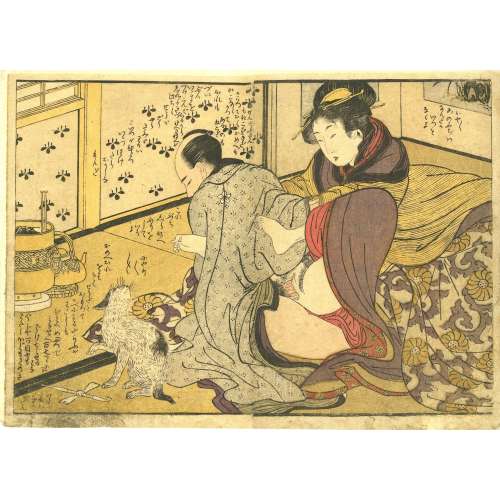 Kitagawa Utamaro. According to Chris Uhlenberg this is an illustration from the book Ehon koi no Onamaki, 3 vols, published in Kansei 11 (1799). Illustrated in b/w in: Hayashi Yoshikazu: Kitagawa Utamaro, in the series: Edo makura-e shi shusei, published in 1990, reissued 1994. Size: Chuban (25.5 x 18.5 cm), two book pages glued together.
Kitagawa Utamaro. According to Chris Uhlenberg this is an illustration from the book Ehon koi no Onamaki, 3 vols, published in Kansei 11 (1799). Illustrated in b/w in: Hayashi Yoshikazu: Kitagawa Utamaro, in the series: Edo makura-e shi shusei, published in 1990, reissued 1994. Size: Chuban (25.5 x 18.5 cm), two book pages glued together. -
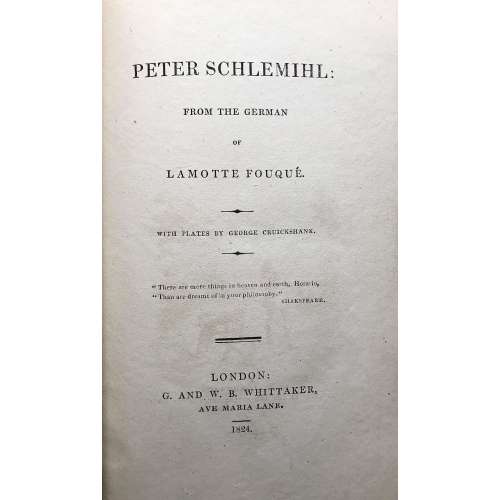 Title: PETER SCHLEMIHL: | FROM THE GERMAN | OF LAMOTTE FOUQUÉ | WITH PLATES BY GEORGE CRUICKSHANK. | "There are more things in heaven and earth, Horatio, | "Than are dreamt of in your philosophy." | SHAKESPEARE. | — | LONDON: | G. AND W. B. WHITTAKER, | AVE MARIA LANE. | 1824.|| Pagination: xii, 165 p. : ill. No Adelbert von Chamisso (German, 1781 – 1838) name on the title page. George Cruikshank's name printed with a typo 'Cruickshank'. The attribution on the title-page to Friedrich de La Motte-Fouqué (German, 1777 – 1843) is erroneous. The original German was edited by La Motte Fouqué. The translation was performed by Sir John Bowring (British, 1792 – 1872) First edition in English, third issue with no hyphen between "Ave" and 'Maria" in publisher's imprint.
Title: PETER SCHLEMIHL: | FROM THE GERMAN | OF LAMOTTE FOUQUÉ | WITH PLATES BY GEORGE CRUICKSHANK. | "There are more things in heaven and earth, Horatio, | "Than are dreamt of in your philosophy." | SHAKESPEARE. | — | LONDON: | G. AND W. B. WHITTAKER, | AVE MARIA LANE. | 1824.|| Pagination: xii, 165 p. : ill. No Adelbert von Chamisso (German, 1781 – 1838) name on the title page. George Cruikshank's name printed with a typo 'Cruickshank'. The attribution on the title-page to Friedrich de La Motte-Fouqué (German, 1777 – 1843) is erroneous. The original German was edited by La Motte Fouqué. The translation was performed by Sir John Bowring (British, 1792 – 1872) First edition in English, third issue with no hyphen between "Ave" and 'Maria" in publisher's imprint.In a cover box of red cloth over cardboard. Box: 21 x 13 x 2.3 cm; book: 19.3 x 11.8 x 1.7 cm; Crown 8vo. Red cardboard binding. Printed spine labels mounted on spine of the box and the book. Untrimmed edges.
Reference: Cohn 475. -
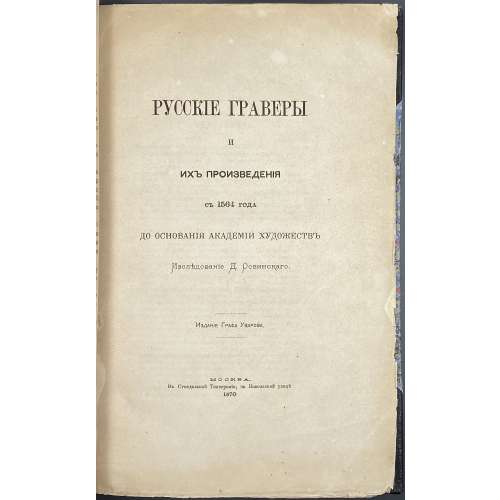 Title: РУССКIЕ ГРАВЕРЫ | И | ИХЪ ПРОИЗВЕДЕНIЯ | СЪ 1564 ГОДА | ДО ОСНОВАНIЯ АКАДЕМIИ ХУДОЖЕСТВЪ. | Изследованiе Д. Ровинскаго. | Изданiе графа Уварова. | МОСКВА. | Въ Сѵнодальной типографiи, на Никольской улицѣ. | 1870. || Pagination: [2] orig. wrapper / advert., [2] t.p. / imp.[i] ii-x, [1] 2-403 [404], [2] orig. wrapper / advert. Collation: 8vo; π6 (incl. t.p.), 1-258 χ2 Binding: Owner’s ½ black morocco over marbled boards, raised bands, gilt-ruled, florets and lettering in compartments, blue endpapers, uncut, untrimmed, original wrappers preserved. Size: 29.5 x 19 cm
Title: РУССКIЕ ГРАВЕРЫ | И | ИХЪ ПРОИЗВЕДЕНIЯ | СЪ 1564 ГОДА | ДО ОСНОВАНIЯ АКАДЕМIИ ХУДОЖЕСТВЪ. | Изследованiе Д. Ровинскаго. | Изданiе графа Уварова. | МОСКВА. | Въ Сѵнодальной типографiи, на Никольской улицѣ. | 1870. || Pagination: [2] orig. wrapper / advert., [2] t.p. / imp.[i] ii-x, [1] 2-403 [404], [2] orig. wrapper / advert. Collation: 8vo; π6 (incl. t.p.), 1-258 χ2 Binding: Owner’s ½ black morocco over marbled boards, raised bands, gilt-ruled, florets and lettering in compartments, blue endpapers, uncut, untrimmed, original wrappers preserved. Size: 29.5 x 19 cm -
![Auguste Vitu. Les réunions publiques à Paris 1868-1869. — Paris: E. Dentu, 1869. — pp.: [1-5] 6-151 [1].](https://varshavskycollection.com/wp-content/uploads/2021/02/LIB-2432.2020-a-500x500.jpeg) Cover: LES | RÉUNIONS PUBLIQUES | A PARIS | 1868 — 1869 | PAR | AUGUSTE VITU | TROISIÈME ÉDITION | Augmentée d’un Appendice contenant les Jugements et Arrêts | rendus à Paris en matière de réunions publiques | PARIS | E. DENTU, LIBRAIRE-ÉDITEUR | PALAIS-ROYAL, 17-19, GALERIE D’ORLÉANS | MAI 1869 || ; t.p. similar with no dash between 17 and 19 in the bottom. Pagination: [1-5] 6-151 [1]; collation: 8vo, [1]8 2-98 103; 23 x 14 cm, publisher’s lettered blue paper wrappers. Printer: Dubuisson et Cie (Paris). Vitu, Auguste-Charles-Joseph (French, 1823 – 1891)
Cover: LES | RÉUNIONS PUBLIQUES | A PARIS | 1868 — 1869 | PAR | AUGUSTE VITU | TROISIÈME ÉDITION | Augmentée d’un Appendice contenant les Jugements et Arrêts | rendus à Paris en matière de réunions publiques | PARIS | E. DENTU, LIBRAIRE-ÉDITEUR | PALAIS-ROYAL, 17-19, GALERIE D’ORLÉANS | MAI 1869 || ; t.p. similar with no dash between 17 and 19 in the bottom. Pagination: [1-5] 6-151 [1]; collation: 8vo, [1]8 2-98 103; 23 x 14 cm, publisher’s lettered blue paper wrappers. Printer: Dubuisson et Cie (Paris). Vitu, Auguste-Charles-Joseph (French, 1823 – 1891) -
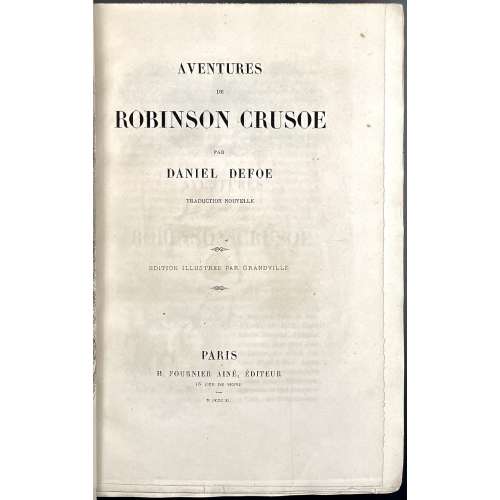 Title page: AVENTURES | DE | ROBINSON CRUSOE | PAR | DANIEL DEFOE | TRADUCTION NOUVELLE | ☙ |EDITION ILLUSTREE PAR GRANDVILLE | ❧ |PARIS | H. FOURNIER AINÉ, ÉDITEUR | 16 RUE DE SEINE | — | M DCCC XL || {sic: no accents in EDITION ILLUSTREE) Pagination: [4] [1]-610, [2] [1]-4., 620 pp. total plus 82 leaves of plates, unpaginated. Collation: 2 binder’s blank leaves, front publisher’s wrapper, h.t / imprint, 2 copies of engraved frontispiece on china paper, t.p. / blank, etc., … text..., back wrapper and spine bound in; 4to: π2 [1]-774 (310 leaves total) plus 40 x 2 plates extraneous to collation. Illustrations: 2 head- and 2 tailpieces, 2 initials, 159 vignettes, and 40 lettered plates each in two variants: one printed on a regular page, and one printed on India paper and pasted to a page. Page size: 24 x 15 cm. Frontispiece: Cut on wood by Louis-Henri Brevière after J. J. Grandville and Français. “Robinson sits on a throne-like chair framed by exotic palm trees. The sculptural and quasi-royal representation of Robinson is flanked by his faithful dog and parrot. The hero’s tools (the gun and the axe) are prominently displayed. He looks to the horizon away to the left, rather than to the tiny ship that can be seen on the horizon. His overcoming of life’s difficult events is at the core of the representation. The massive plinth reinforces the aura of the hero, as do the tiny people admiring the sculpture and learning about the heroic figure. Friday is discreetly represented in a medallion on the plinth along with other decorations including goats and a «savage»". [Sitzia, E. (2020). Lost in Intersemiotic Translation? J.J. Grandville’s Illustration of Robinson Crusoe. Journal for Literary and Intermedial Crossings, 5(2). https://clic.research.vub.be/sites/default/files/atoms/files/SITZIA_FIN.pdf] The monument has an inscription: “ FERNAND | SUEZ” which we deciphered as either a tribute to Juan Fernández (Spanish, c. 1536 – c. 1604) or as a mention of the place where Crusoe’s adventures took place: Archipiélago Juan Fernández to which Isla Róbinson Crusoe belongs. Binding: 24.8 x 16.4 cm, by Emile Mercier, half green crushed morocco over marbled boards, gilt-ruled, spine ornately gilt, sunned to orange tone, marbled endpapers, publisher's pale yellow wrappers bound in; only the top edge trimmed. Contributors: Daniel Defoe (British, 1660 – 1731) – author. J. J. Grandville [Gèrard, Isidore-Adolphe] (French, 1803 – 1847) – artist. François-Louis Français (French, 1814 – 1897) – artist (frontispiece, landscapes). Engravers: John Quartley (British, fl. 1835 – 1867) Matthew Urlwin Sears (British, 1799 – 1870) Adolphe Best (French, 1808 – 1860) One of the Guillaumots: Eugène Guillaumot (French, Paris 1813–1869), or Auguste Etienne Guillaumot (French,1844 – 1890), or his father Auguste-Alexandre Guillaumot (French, 1815 – 1892) Laisné [Alfred, Adèle, and Aglaé] (French, active 1835–1868) Antoine-Alphée Piaud (French, 1813 – 1867) Louis Dujardin (French, 1808 – 1859) A. Hans (nothing is known) Jean Louis Joseph Camille Lacoste (French, 1809 – 1866) Louis-Henri Brevière (French, 1797 – 1869) – vignettes. Provenance: Bishop, Cortlandt Field (American, 1870 – 1935) – bookplate; Mary S. Collins – bookplate by J. H. Fincken Robin F. Satinsky (American, 1919 – 2008) – Robin Collection bookplate. Catalogue raisonné: Brivois (1883) p. 155; Ray (French): № 193, p. 272; Carteret (1927): p. 241. All indicated in-8vo, which doesn't correspond to our in-4to copy.
Title page: AVENTURES | DE | ROBINSON CRUSOE | PAR | DANIEL DEFOE | TRADUCTION NOUVELLE | ☙ |EDITION ILLUSTREE PAR GRANDVILLE | ❧ |PARIS | H. FOURNIER AINÉ, ÉDITEUR | 16 RUE DE SEINE | — | M DCCC XL || {sic: no accents in EDITION ILLUSTREE) Pagination: [4] [1]-610, [2] [1]-4., 620 pp. total plus 82 leaves of plates, unpaginated. Collation: 2 binder’s blank leaves, front publisher’s wrapper, h.t / imprint, 2 copies of engraved frontispiece on china paper, t.p. / blank, etc., … text..., back wrapper and spine bound in; 4to: π2 [1]-774 (310 leaves total) plus 40 x 2 plates extraneous to collation. Illustrations: 2 head- and 2 tailpieces, 2 initials, 159 vignettes, and 40 lettered plates each in two variants: one printed on a regular page, and one printed on India paper and pasted to a page. Page size: 24 x 15 cm. Frontispiece: Cut on wood by Louis-Henri Brevière after J. J. Grandville and Français. “Robinson sits on a throne-like chair framed by exotic palm trees. The sculptural and quasi-royal representation of Robinson is flanked by his faithful dog and parrot. The hero’s tools (the gun and the axe) are prominently displayed. He looks to the horizon away to the left, rather than to the tiny ship that can be seen on the horizon. His overcoming of life’s difficult events is at the core of the representation. The massive plinth reinforces the aura of the hero, as do the tiny people admiring the sculpture and learning about the heroic figure. Friday is discreetly represented in a medallion on the plinth along with other decorations including goats and a «savage»". [Sitzia, E. (2020). Lost in Intersemiotic Translation? J.J. Grandville’s Illustration of Robinson Crusoe. Journal for Literary and Intermedial Crossings, 5(2). https://clic.research.vub.be/sites/default/files/atoms/files/SITZIA_FIN.pdf] The monument has an inscription: “ FERNAND | SUEZ” which we deciphered as either a tribute to Juan Fernández (Spanish, c. 1536 – c. 1604) or as a mention of the place where Crusoe’s adventures took place: Archipiélago Juan Fernández to which Isla Róbinson Crusoe belongs. Binding: 24.8 x 16.4 cm, by Emile Mercier, half green crushed morocco over marbled boards, gilt-ruled, spine ornately gilt, sunned to orange tone, marbled endpapers, publisher's pale yellow wrappers bound in; only the top edge trimmed. Contributors: Daniel Defoe (British, 1660 – 1731) – author. J. J. Grandville [Gèrard, Isidore-Adolphe] (French, 1803 – 1847) – artist. François-Louis Français (French, 1814 – 1897) – artist (frontispiece, landscapes). Engravers: John Quartley (British, fl. 1835 – 1867) Matthew Urlwin Sears (British, 1799 – 1870) Adolphe Best (French, 1808 – 1860) One of the Guillaumots: Eugène Guillaumot (French, Paris 1813–1869), or Auguste Etienne Guillaumot (French,1844 – 1890), or his father Auguste-Alexandre Guillaumot (French, 1815 – 1892) Laisné [Alfred, Adèle, and Aglaé] (French, active 1835–1868) Antoine-Alphée Piaud (French, 1813 – 1867) Louis Dujardin (French, 1808 – 1859) A. Hans (nothing is known) Jean Louis Joseph Camille Lacoste (French, 1809 – 1866) Louis-Henri Brevière (French, 1797 – 1869) – vignettes. Provenance: Bishop, Cortlandt Field (American, 1870 – 1935) – bookplate; Mary S. Collins – bookplate by J. H. Fincken Robin F. Satinsky (American, 1919 – 2008) – Robin Collection bookplate. Catalogue raisonné: Brivois (1883) p. 155; Ray (French): № 193, p. 272; Carteret (1927): p. 241. All indicated in-8vo, which doesn't correspond to our in-4to copy. -
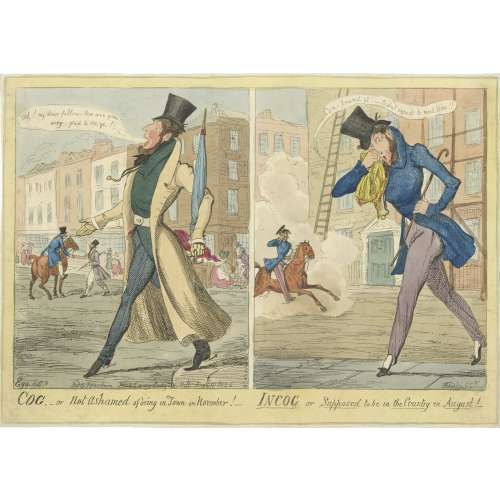 Description by British Museum (1865,1111.2128): "Two designs, side by side. [1] A dandy (probably a portrait), florid, whiskered, and bearded, steps jauntily from the pavement, hand extended, saying: Ah! my dear fellow — How are you? Devilish glad to see ye!— He holds a closed umbrella, ferrule erect, and wears a long tight-waisted coat to the heels, unbuttoned, tight pantaloons and spurred boots. In the middle distance, another dandy grasps the hand of a friend on horseback. Behind are houses with shop-fronts. A man raises his hat to a lady who curtseys. [2] The same dandy steps from the roadway onto the pavement, his handkerchief to his nose; he stoops, trying to conceal himself from a dandy cantering past in a cloud of dust, his eye-glass to his eye. He is without gloves, extraordinary for a dandy, and his trousers are strapped over pumps; he says: Con-found it! — Didn't expect to meet Him!! The street is otherwise empty; against the (large) houses are scaffolding and a tall ladder." Lettered with title, text within image including production details: 'Ego. delt / Etched by G. Ck / Pubd by J Fairburn Broadway Ludgate Hill August 18 1826'. Dimensions: Sheet: 25.5 x 36 cm, Image: 21.7 x 33.8 cm. Catalogue raisonné: A. M. Cohn (1924): № 1001, p. 262.: "A wretched plate. Difficult to believe G. C. had anything to do with it." — Bruton. Value.— £1.
Description by British Museum (1865,1111.2128): "Two designs, side by side. [1] A dandy (probably a portrait), florid, whiskered, and bearded, steps jauntily from the pavement, hand extended, saying: Ah! my dear fellow — How are you? Devilish glad to see ye!— He holds a closed umbrella, ferrule erect, and wears a long tight-waisted coat to the heels, unbuttoned, tight pantaloons and spurred boots. In the middle distance, another dandy grasps the hand of a friend on horseback. Behind are houses with shop-fronts. A man raises his hat to a lady who curtseys. [2] The same dandy steps from the roadway onto the pavement, his handkerchief to his nose; he stoops, trying to conceal himself from a dandy cantering past in a cloud of dust, his eye-glass to his eye. He is without gloves, extraordinary for a dandy, and his trousers are strapped over pumps; he says: Con-found it! — Didn't expect to meet Him!! The street is otherwise empty; against the (large) houses are scaffolding and a tall ladder." Lettered with title, text within image including production details: 'Ego. delt / Etched by G. Ck / Pubd by J Fairburn Broadway Ludgate Hill August 18 1826'. Dimensions: Sheet: 25.5 x 36 cm, Image: 21.7 x 33.8 cm. Catalogue raisonné: A. M. Cohn (1924): № 1001, p. 262.: "A wretched plate. Difficult to believe G. C. had anything to do with it." — Bruton. Value.— £1. -
 Title: Seventh lunar month [初秋] (Hatsuaki no zu); Series: Fashionable Twelve Months (Imayo juni-kagetsu). Another version of translation: Modern Beauties of Twelve Months. Artist: Utagawa Toyokuni I [歌川豊国] (1769–1825). Pubisher: Ibaya Senzaburō [伊場屋仙三郎] (Japanese, 1815 – 1869), seal: Dansendō [伊場仙]. Signed: Toyokuni ga and sealed with toshidama. Date-kiwame seal: Ushi (ox), Bunsei 5 (1822). Size: double-sheet uncut fan print ( aiban uchiwa-e), 219 x 295 mm.
Title: Seventh lunar month [初秋] (Hatsuaki no zu); Series: Fashionable Twelve Months (Imayo juni-kagetsu). Another version of translation: Modern Beauties of Twelve Months. Artist: Utagawa Toyokuni I [歌川豊国] (1769–1825). Pubisher: Ibaya Senzaburō [伊場屋仙三郎] (Japanese, 1815 – 1869), seal: Dansendō [伊場仙]. Signed: Toyokuni ga and sealed with toshidama. Date-kiwame seal: Ushi (ox), Bunsei 5 (1822). Size: double-sheet uncut fan print ( aiban uchiwa-e), 219 x 295 mm.

-
 Artist: Utagawa Kunisada [歌川 国貞] a.k.a. Utagawa Toyokuni III [三代歌川豊国] (Japanese, 1786 – 1865). Signed: Ichiyōsai Toyokuni hitsu [一陽斎豊国筆]. Inscriptions: [松竹梅] Shochikubai = pine (matsu, 松), bamboo (take, 竹), and plum (ume, 梅) – an auspicious grouping known as "The Three Friends of Winter"; [三福追] (Sanpuku tsui) – the three delights, or pleasures. Date seal and aratame censor seal: Ansei 2, 1st month (1855). Publisher: Ibaya Senzaburō [伊場屋仙三郎] (Japanese, c. 1815 – 1869). Block carver: Yokokawa Takejirō [横川竹二郎] (Japanese, fl. 1845 – 1863); seal: Hori Take [彫竹]. Kabuki actor Nakamura Shikan IV [中村芝翫] (Nakamura Fukusuke I [中村福助], Nakamura Masanosuke I, Nakamura Komasaburō, Nakamura Tamatarō I, Japanese, 1831 – 1899) arranging a branch of blossoming plum to the memorial portrait of his predecessor Nakamura Utaemon IV [中村歌右衛門] (Nakamura Shikan II, Nakamura Tsurusuke I, Nakamura Tōtarō, Japanese, 1796 – 1852); the latter is dressed in a black robe adorned with a mokkō-crest (mon) of white plum blossom, the hanging scroll border decorated with arabesque and plum blossoms. Actors identified by Horst Graebner. Two fan prints from this series in Varshavsky Collection:
Artist: Utagawa Kunisada [歌川 国貞] a.k.a. Utagawa Toyokuni III [三代歌川豊国] (Japanese, 1786 – 1865). Signed: Ichiyōsai Toyokuni hitsu [一陽斎豊国筆]. Inscriptions: [松竹梅] Shochikubai = pine (matsu, 松), bamboo (take, 竹), and plum (ume, 梅) – an auspicious grouping known as "The Three Friends of Winter"; [三福追] (Sanpuku tsui) – the three delights, or pleasures. Date seal and aratame censor seal: Ansei 2, 1st month (1855). Publisher: Ibaya Senzaburō [伊場屋仙三郎] (Japanese, c. 1815 – 1869). Block carver: Yokokawa Takejirō [横川竹二郎] (Japanese, fl. 1845 – 1863); seal: Hori Take [彫竹]. Kabuki actor Nakamura Shikan IV [中村芝翫] (Nakamura Fukusuke I [中村福助], Nakamura Masanosuke I, Nakamura Komasaburō, Nakamura Tamatarō I, Japanese, 1831 – 1899) arranging a branch of blossoming plum to the memorial portrait of his predecessor Nakamura Utaemon IV [中村歌右衛門] (Nakamura Shikan II, Nakamura Tsurusuke I, Nakamura Tōtarō, Japanese, 1796 – 1852); the latter is dressed in a black robe adorned with a mokkō-crest (mon) of white plum blossom, the hanging scroll border decorated with arabesque and plum blossoms. Actors identified by Horst Graebner. Two fan prints from this series in Varshavsky Collection:
SVJP-0336.2021
-
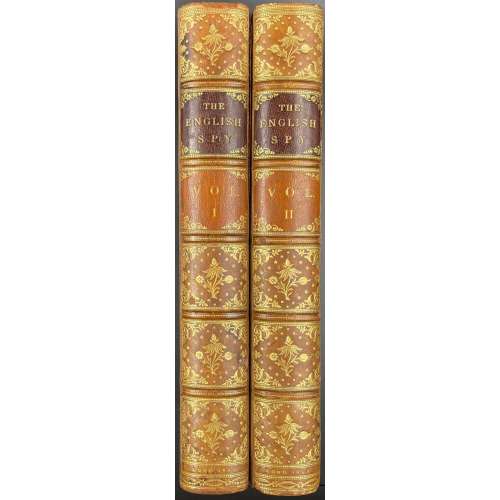 Two volumes 23.2 x 15.6 cm, uniformly bound in full polished calf by Riviere and Son (signed on fep verso), boards with triple gilt fillet border, spine with raised bands, gilt in compartments, gilt-lettered labels; dark blue endpapers, armorial bookplate of William Jennings with the motto “Honor Virtutis Premium” to front pastedown. Vol. 1: THE | ENGLISH SPY: | An Original Work | CHARACTERISTIC, SATIRICAL, AND | HUMOROUS. | COMPRISING | SCENES AND SKETCHES IN EVERY RANK OF SOCIETY, | BEING | PORTRAITS | OF THE | Illustrious, Eminent, Eccentric, and Notorious. | DRAWN FROM THE LIFE | BY BERNARD BLACKMANTLE. | THE ILLUSTRATIONS | DESIGNED BY | ROBERT CRUIKSHANK. | {vignette w/inscription: ‘By Frolic, Mirth, and Fancy gay, | Old Father Time is borne away.’ | — | LONDON : | PUBLISHED BY SHERWOOD, JONES, AND CO. | PATERNOSTER-ROW. | – | 1825. || Collation: [a]8 b4 B-H8 I4 K2 L-Z8 2A-2E8 2F3; total 221 leaves Pagination: [i-iii] iv-xxiii [xxiv] [1-3] 4-417 [418]; total 442 pages. Illustrations: 35 coloured plates, 1 uncoloured plate, and 29 woodcuts in text, incl vignette on title, all but four by Robert Cruikshank, 1 by G. M.B rightly (p. 335), 1 by T. Wageman (p. 413), and 2 by T. Rowlandson (pp. 411 and 416) Vol. 2: THE | ENGLISH SPY: | An Original Work | CHARACTERISTIC, SATIRICAL, AND | HUMOROUS. | COMPRISING | SCENES AND SKETCHES IN EVERY RANK OF SOCIETY, | BEING | PORTRAITS | OF THE | Illustrious, Eminent, Eccentric, and Notorious. | DRAWN FROM THE LIFE | BY BERNARD BLACKMANTLE. | THE ILLUSTRATIONS | DESIGNED BY | ROBERT CRUIKSHANK. | — | VOL. II. | — | {vignette w/inscription: ‘By Frolic, Mirth, and Fancy gay, | Old Father Time is borne away.’ | — | LONDON : | PUBLISHED BY SHERWOOD, GILBERT, AND PIPER, | PATERNOSTER-ROW. | – | 1826. || Collation: [A]-Z8 2A-2C8; total 208 leaves. [i-iii] iv-xv [xvi] [1-3] 4-399 [400]; total 416 pages. Illustrations: 36 coloured plates and 25 woodcuts in text. Catalogue raisonné: Martin-Hardie pp. 191-2; Tooley pp. 266-9; Abbey 325, pp.272-4 (see reflections regarding the ‘first issue’). Contributors: Charles Molloy Westmacott (British, c. 1788 – 1868) – author. Isaac Robert Cruikshank (British, 1789 – 1856) – artist, engraver. G. M. Brightly (British, fl. 1809 – 1827) – artist, engraver. Thomas Charles Wageman (British, 1787-1868) – artist, engraver Thomas Rowlandson (British, 1757 – 1827) – artist. Thomas Davison (British, 1794 – 1826) – printer. Sherwood, Jones, and Co. (London) – publisher. Sherwood, Gilbert, and Piper (London) – publisher. William Jennings – provenance
Two volumes 23.2 x 15.6 cm, uniformly bound in full polished calf by Riviere and Son (signed on fep verso), boards with triple gilt fillet border, spine with raised bands, gilt in compartments, gilt-lettered labels; dark blue endpapers, armorial bookplate of William Jennings with the motto “Honor Virtutis Premium” to front pastedown. Vol. 1: THE | ENGLISH SPY: | An Original Work | CHARACTERISTIC, SATIRICAL, AND | HUMOROUS. | COMPRISING | SCENES AND SKETCHES IN EVERY RANK OF SOCIETY, | BEING | PORTRAITS | OF THE | Illustrious, Eminent, Eccentric, and Notorious. | DRAWN FROM THE LIFE | BY BERNARD BLACKMANTLE. | THE ILLUSTRATIONS | DESIGNED BY | ROBERT CRUIKSHANK. | {vignette w/inscription: ‘By Frolic, Mirth, and Fancy gay, | Old Father Time is borne away.’ | — | LONDON : | PUBLISHED BY SHERWOOD, JONES, AND CO. | PATERNOSTER-ROW. | – | 1825. || Collation: [a]8 b4 B-H8 I4 K2 L-Z8 2A-2E8 2F3; total 221 leaves Pagination: [i-iii] iv-xxiii [xxiv] [1-3] 4-417 [418]; total 442 pages. Illustrations: 35 coloured plates, 1 uncoloured plate, and 29 woodcuts in text, incl vignette on title, all but four by Robert Cruikshank, 1 by G. M.B rightly (p. 335), 1 by T. Wageman (p. 413), and 2 by T. Rowlandson (pp. 411 and 416) Vol. 2: THE | ENGLISH SPY: | An Original Work | CHARACTERISTIC, SATIRICAL, AND | HUMOROUS. | COMPRISING | SCENES AND SKETCHES IN EVERY RANK OF SOCIETY, | BEING | PORTRAITS | OF THE | Illustrious, Eminent, Eccentric, and Notorious. | DRAWN FROM THE LIFE | BY BERNARD BLACKMANTLE. | THE ILLUSTRATIONS | DESIGNED BY | ROBERT CRUIKSHANK. | — | VOL. II. | — | {vignette w/inscription: ‘By Frolic, Mirth, and Fancy gay, | Old Father Time is borne away.’ | — | LONDON : | PUBLISHED BY SHERWOOD, GILBERT, AND PIPER, | PATERNOSTER-ROW. | – | 1826. || Collation: [A]-Z8 2A-2C8; total 208 leaves. [i-iii] iv-xv [xvi] [1-3] 4-399 [400]; total 416 pages. Illustrations: 36 coloured plates and 25 woodcuts in text. Catalogue raisonné: Martin-Hardie pp. 191-2; Tooley pp. 266-9; Abbey 325, pp.272-4 (see reflections regarding the ‘first issue’). Contributors: Charles Molloy Westmacott (British, c. 1788 – 1868) – author. Isaac Robert Cruikshank (British, 1789 – 1856) – artist, engraver. G. M. Brightly (British, fl. 1809 – 1827) – artist, engraver. Thomas Charles Wageman (British, 1787-1868) – artist, engraver Thomas Rowlandson (British, 1757 – 1827) – artist. Thomas Davison (British, 1794 – 1826) – printer. Sherwood, Jones, and Co. (London) – publisher. Sherwood, Gilbert, and Piper (London) – publisher. William Jennings – provenance -
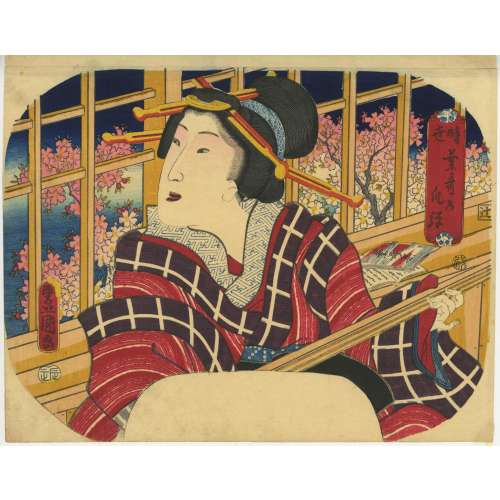 Artist: Utagawa Kunisada [歌川 国貞], a.k.a. Utagawa Toyokuni III [三代 歌川 豊国] (Japanese, 1786 – 1865). Signed: Toyokuni ga [豊国 画] in a red toshidama cartouche Publisher: Iseya Ichiemon [伊勢屋市右衛門] (Japanese, fl. c. 1820s – c. 1860s); seal Tsuji [辻] (Marks 16-029). Media: Untrimmed fan print (uchiwa-e), 225 x 295 mm, plus 10 mm paper strip glued on top (235 mm total height). Title: Plucking Popular Songs in Those Days [時世葉歌の爪弾] (Imayo ha-uta no tsuma-biki). Date seal and aratame seal: Ansei 3 (1856). Seller's Description: Uchiwa-e; picture intended for a summer fan. Here we see a relaxed beauty wearing loose layers of kimono and playing her shamisen instrument. She appears to be in the happy mood of spring, her singing inspired by the cherry blossoms in full bloom that we see outside of her window. She enjoys leisurely plucking with the plectrum of the shamisen and singing “ha-uta” (popular) songs. The title Ha-uta [葉歌] is normally written 端歌, which indicates a certain category of popular songs accompanied by shamisen with short texts that are drawn from daily life. Here however, the title葉歌 uses phonetically the same “ha葉“, referring to the title of the book of a collection of ha-uta songs, Matsu no ha [松の], which was published in five volumes in 1703 by Shûshôken 秀松軒. It is said that this collection of songs was written and sung by the blind (who were often musicians by livelihood). Behind her, lying on the window sill, we see two ha-uta songbooks, one open and one closed. The last half of the title tsuma-biki [爪弾] translates “to pluck with fingers” instead of a plectrum, which is the usual way of playing the shamisen.
Artist: Utagawa Kunisada [歌川 国貞], a.k.a. Utagawa Toyokuni III [三代 歌川 豊国] (Japanese, 1786 – 1865). Signed: Toyokuni ga [豊国 画] in a red toshidama cartouche Publisher: Iseya Ichiemon [伊勢屋市右衛門] (Japanese, fl. c. 1820s – c. 1860s); seal Tsuji [辻] (Marks 16-029). Media: Untrimmed fan print (uchiwa-e), 225 x 295 mm, plus 10 mm paper strip glued on top (235 mm total height). Title: Plucking Popular Songs in Those Days [時世葉歌の爪弾] (Imayo ha-uta no tsuma-biki). Date seal and aratame seal: Ansei 3 (1856). Seller's Description: Uchiwa-e; picture intended for a summer fan. Here we see a relaxed beauty wearing loose layers of kimono and playing her shamisen instrument. She appears to be in the happy mood of spring, her singing inspired by the cherry blossoms in full bloom that we see outside of her window. She enjoys leisurely plucking with the plectrum of the shamisen and singing “ha-uta” (popular) songs. The title Ha-uta [葉歌] is normally written 端歌, which indicates a certain category of popular songs accompanied by shamisen with short texts that are drawn from daily life. Here however, the title葉歌 uses phonetically the same “ha葉“, referring to the title of the book of a collection of ha-uta songs, Matsu no ha [松の], which was published in five volumes in 1703 by Shûshôken 秀松軒. It is said that this collection of songs was written and sung by the blind (who were often musicians by livelihood). Behind her, lying on the window sill, we see two ha-uta songbooks, one open and one closed. The last half of the title tsuma-biki [爪弾] translates “to pluck with fingers” instead of a plectrum, which is the usual way of playing the shamisen. -
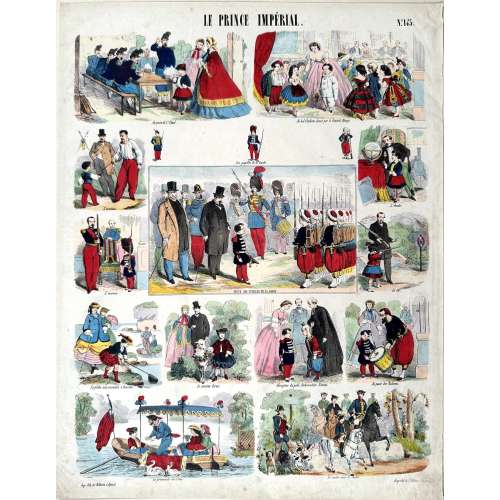 Hand-coloured woodcut on wove paper, 472 x 365 mm; black ink stamp “5275” to reverse. Top centre: "LE PRINCE IMPÉRIAL"; right: "№143." Image in the middle: Prince Impérial, with his father, conducts a review of the children's army "REVUE DES PUPILLES DE LA GARDE". Besides – five tiers of captioned cartoons. Bottom left: "Imp. lith. de Pellerin à Épinal"; right: Propriété de l’Éditeur. Déposé." Jean Charles Pellerin (French, 1756 – 1836) – printer/publisher.
Hand-coloured woodcut on wove paper, 472 x 365 mm; black ink stamp “5275” to reverse. Top centre: "LE PRINCE IMPÉRIAL"; right: "№143." Image in the middle: Prince Impérial, with his father, conducts a review of the children's army "REVUE DES PUPILLES DE LA GARDE". Besides – five tiers of captioned cartoons. Bottom left: "Imp. lith. de Pellerin à Épinal"; right: Propriété de l’Éditeur. Déposé." Jean Charles Pellerin (French, 1756 – 1836) – printer/publisher. -
 Torii Kiyomitsu II (Kiyomine), Japanese, 1787–1868. Courtesan and her Komura (Doll Festival). Series: Furyu Goyo no Matsu (Customs of 5 Pine Needles, the 5 great festivals). Publisher: Tsuruya Kiemon [Marks: 553].
Torii Kiyomitsu II (Kiyomine), Japanese, 1787–1868. Courtesan and her Komura (Doll Festival). Series: Furyu Goyo no Matsu (Customs of 5 Pine Needles, the 5 great festivals). Publisher: Tsuruya Kiemon [Marks: 553]. -
 Utagawa Kunisada (Japanese: 歌川 国貞; also known as Utagawa Toyokuni III (三代歌川豊国); 1786 – 12 January 1865).
Utagawa Kunisada (Japanese: 歌川 国貞; also known as Utagawa Toyokuni III (三代歌川豊国); 1786 – 12 January 1865).A young woman reading a book in the light of a lamp. Series: Arigataki miyo no kage-e (Shadow Pictures of an Auspicious Age). There are five known prints, half-length portraits of beauties, in this series, designed by Kunisada in ca. 1844. Another print from the series in this collection: SVJP-0306.2020: A young woman adjusting her hairpins in the light of a paper lantern.
Signed: Kōchōrō Toyokuni ga (香蝶楼豊国画).
Publisher: Maruya Kiyojiro.
Size: Vertical Ōban (37.5 x 25.4 cm). -
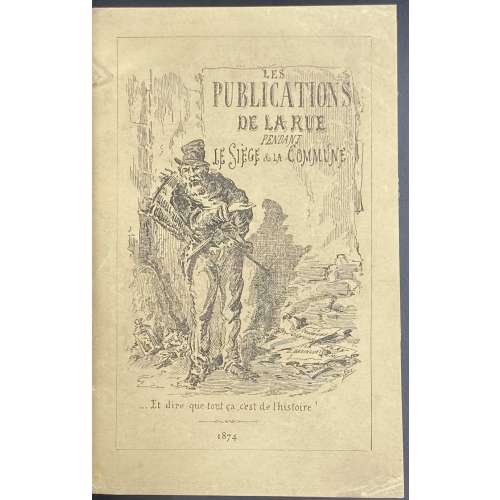 Convolute with three editions, dedicated to the Commune of Paris, 1871. (1) LES | Publications de la Rue | pendant | LE SIEGE ET LA COMMUNE | SATIRES — CANARDS — COMPLAINTES — CHANSONS | PLACARDS ET PAMPHLETS | BIBLIOGRAPHIE | PITTORESQUE ET ANECDOTIQUE | Par Firmin MAILLARD |{publisher’s device}| PARIS | AUGUSTE AUBRY, ÉDITEUR | 18, RUE SÉGUIER, 18 | 1874 || Pagination: ffl, original pictorial wrapper, [2] – blank / advert., [2] – h.t. / blank, [2] – h.t. / colophon imprim. PILLET FILS AINÉ, frontis. similar to front wrapper without '1874', [2] – t.p. / blank, [v] vi-xii, [1] 2-198, three blank leaves, back wrapper. (2) VILLE DE SAINT-DENIS | EXPOSITION D'ART & D'HISTOIRE | La Commune de Paris |18 Mars 1871 28 Mai | AVANT-PROPOS DE Lucien DESCAVES | de l’Académie Goncourt | PREFACE DE Jacques DORIOT | Député de la Seine, Maire de Saint-Denis | Du 17 Mars au 26 Mai 1935 | au Musée Municipal | 4, place de la Légion d’Honneur – Saint-Denis || Pagination: original pictorial wrapper in black and red, frontis., [2] - t.p. / blank, [2] – commité, v-xiii [xiv] 1-113 [114], 26 plates (13 leaves), blank back wrapper, spine tipped-in. (3) J. LEMONNYER | LES | JOURNAUX DE PARIS | PENDANT | LA COMMUNE | REVUE BIBLIOGRAPHIQUE COMPLETE | DE LA PRESSE PARISIENNE | du 19 Mars au 27 Mai | AVEC |{7 lines of text}| ET | UNE TABLE ALPHABÉTIQUE | DONNANT LE PRIX-COURANT DE CHAQUE COLLECTION | PARIS : J. LEMONNYER, Librarire | 73, Rue de Provence, 73 || Pagination: [2] - t.p. / blank, [2] – preface, [7] 8-94, green back wrapper w/advert., bfl. (lacks original front wrapper). Binding: Modern (20th century) red cloth, black label with gilt lettering to spine, matching marbled endpapers. Size: 18.5 x 13 cm; 12mo.
Convolute with three editions, dedicated to the Commune of Paris, 1871. (1) LES | Publications de la Rue | pendant | LE SIEGE ET LA COMMUNE | SATIRES — CANARDS — COMPLAINTES — CHANSONS | PLACARDS ET PAMPHLETS | BIBLIOGRAPHIE | PITTORESQUE ET ANECDOTIQUE | Par Firmin MAILLARD |{publisher’s device}| PARIS | AUGUSTE AUBRY, ÉDITEUR | 18, RUE SÉGUIER, 18 | 1874 || Pagination: ffl, original pictorial wrapper, [2] – blank / advert., [2] – h.t. / blank, [2] – h.t. / colophon imprim. PILLET FILS AINÉ, frontis. similar to front wrapper without '1874', [2] – t.p. / blank, [v] vi-xii, [1] 2-198, three blank leaves, back wrapper. (2) VILLE DE SAINT-DENIS | EXPOSITION D'ART & D'HISTOIRE | La Commune de Paris |18 Mars 1871 28 Mai | AVANT-PROPOS DE Lucien DESCAVES | de l’Académie Goncourt | PREFACE DE Jacques DORIOT | Député de la Seine, Maire de Saint-Denis | Du 17 Mars au 26 Mai 1935 | au Musée Municipal | 4, place de la Légion d’Honneur – Saint-Denis || Pagination: original pictorial wrapper in black and red, frontis., [2] - t.p. / blank, [2] – commité, v-xiii [xiv] 1-113 [114], 26 plates (13 leaves), blank back wrapper, spine tipped-in. (3) J. LEMONNYER | LES | JOURNAUX DE PARIS | PENDANT | LA COMMUNE | REVUE BIBLIOGRAPHIQUE COMPLETE | DE LA PRESSE PARISIENNE | du 19 Mars au 27 Mai | AVEC |{7 lines of text}| ET | UNE TABLE ALPHABÉTIQUE | DONNANT LE PRIX-COURANT DE CHAQUE COLLECTION | PARIS : J. LEMONNYER, Librarire | 73, Rue de Provence, 73 || Pagination: [2] - t.p. / blank, [2] – preface, [7] 8-94, green back wrapper w/advert., bfl. (lacks original front wrapper). Binding: Modern (20th century) red cloth, black label with gilt lettering to spine, matching marbled endpapers. Size: 18.5 x 13 cm; 12mo.







